Have you ever hiked through Montana’s majestic landscapes and come across a vibrant tapestry of colors of flowers bordering your trail? That spellbinding beauty isn’t just a stroke of luck — it’s the rich collection of Montana wildflowers adorning the verdant countryside.
So, who’s the lucky wildflower aficionado who’s discovering these 47 breathtaking Montana wildflowers? If you share my passion for nature, photography, or simply finding unique flowers, this article is just for you.
- Related article: Montana Nature
Using my expert knowledge and personal adventures, we’ll uncover where to find these delightful blooms, key seasons for their display, and interesting facts that will turn your next walk into a captivating botanical journey. What are you waiting for? Let’s together unearth the hidden floral treasures Montana has to offer.
47 Wildflowers You Can Find Montana
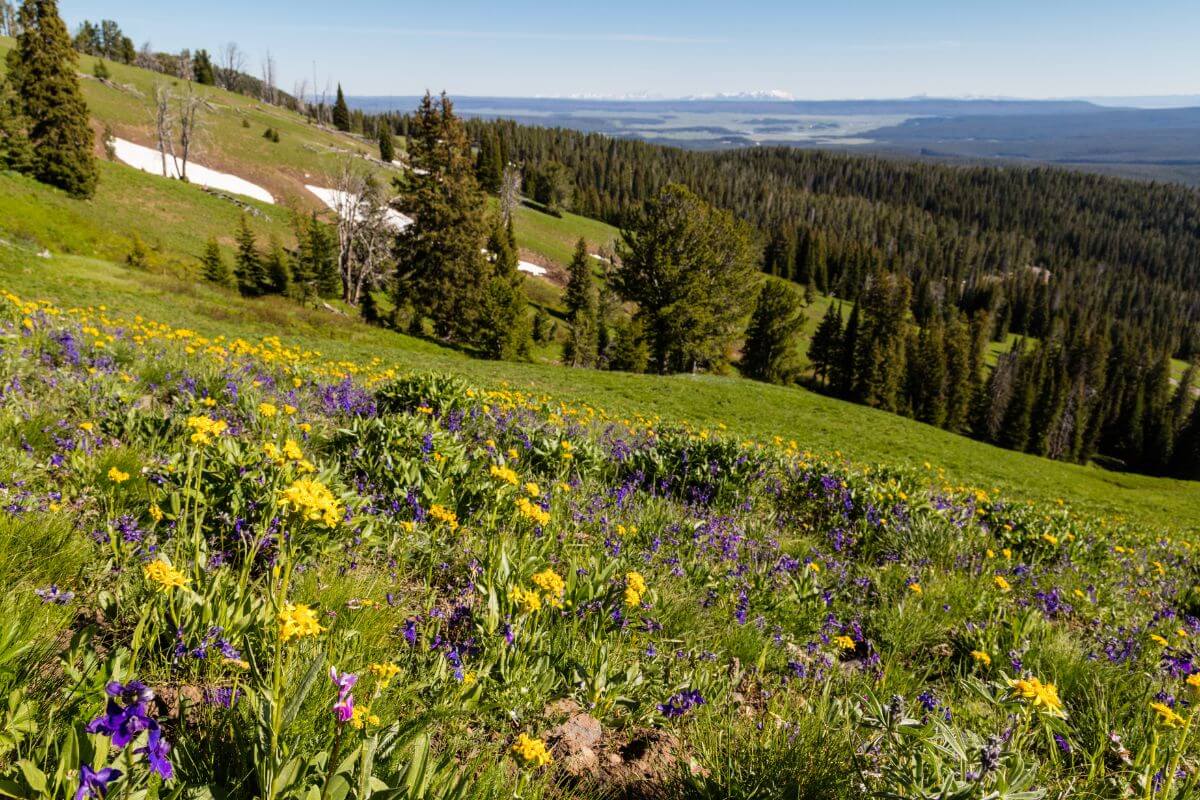
The Big Sky State is home to an array of breathtaking wildflowers, each adding vibrant color to the vast and diverse landscapes. Much like Montana’s native tree species, these wildflowers can be found in meadows, forests, and alpine regions, creating a beautiful natural tapestry.
1. Glacier Lily
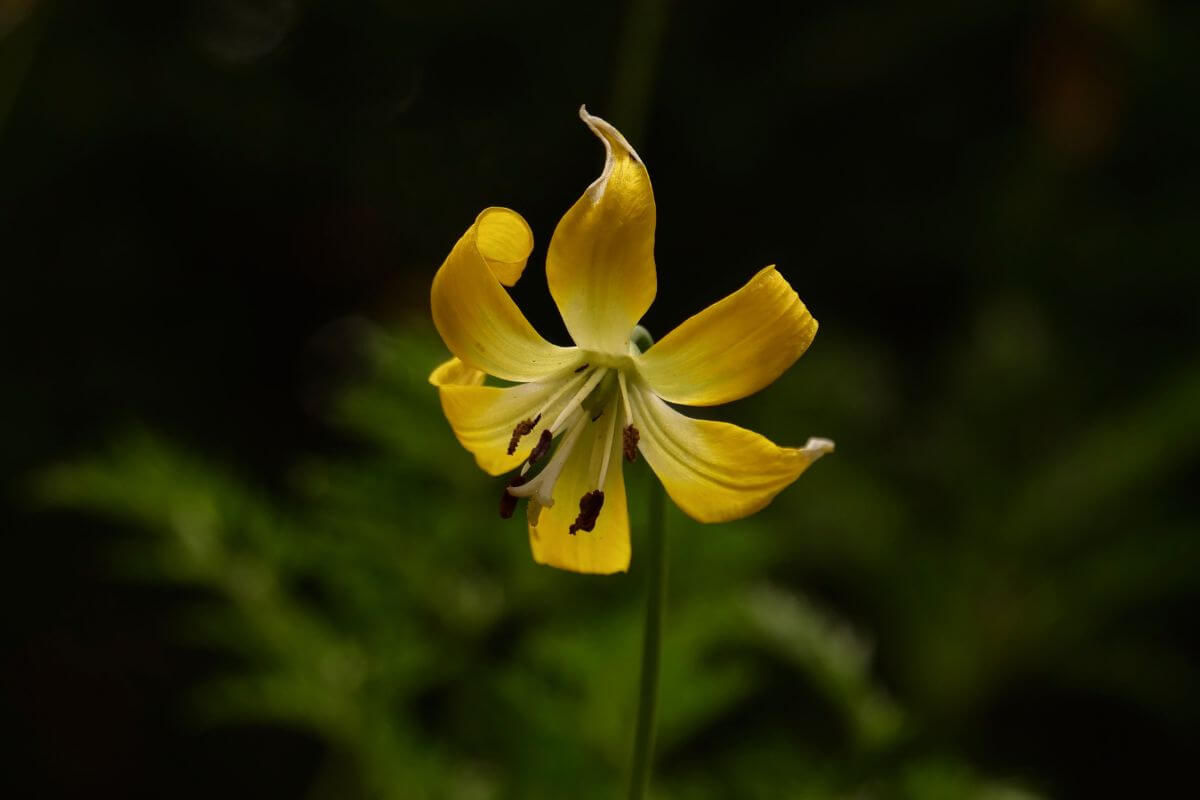
| Attribute | Description |
| Scientific Name | Erythronium grandiflorum |
| Common Name | Glacier Lily (Yellow Avalanche-lily) |
| Native Region | Montana |
| Growth Type | Perennial |
| Growth Form | Large patches, reaching a height of 10-40 cm |
The Glacier Lily can be found in various regions, including Montana, and is known for its characteristic appearance at the edge of receding snow banks. It carpets mountain meadows with lemon-yellow blossoms in late spring and early summer, adding vibrant color to the landscape.
The flowers of the Glacier Lily are regular, narrowly campanulate, and open to star-shaped in full sun. They have yellow, rarely white, separate, narrowly lanceolate, and reflexed tepals, along with the many-seeded capsules they produce.
There are two varieties of the Glacier Lily: var. grandiflorum with yellow tepals and var. candidum with white tepals and yellow bases. These varieties add to the diversity and beauty of the wildflowers found in the state.
2. Shooting Star
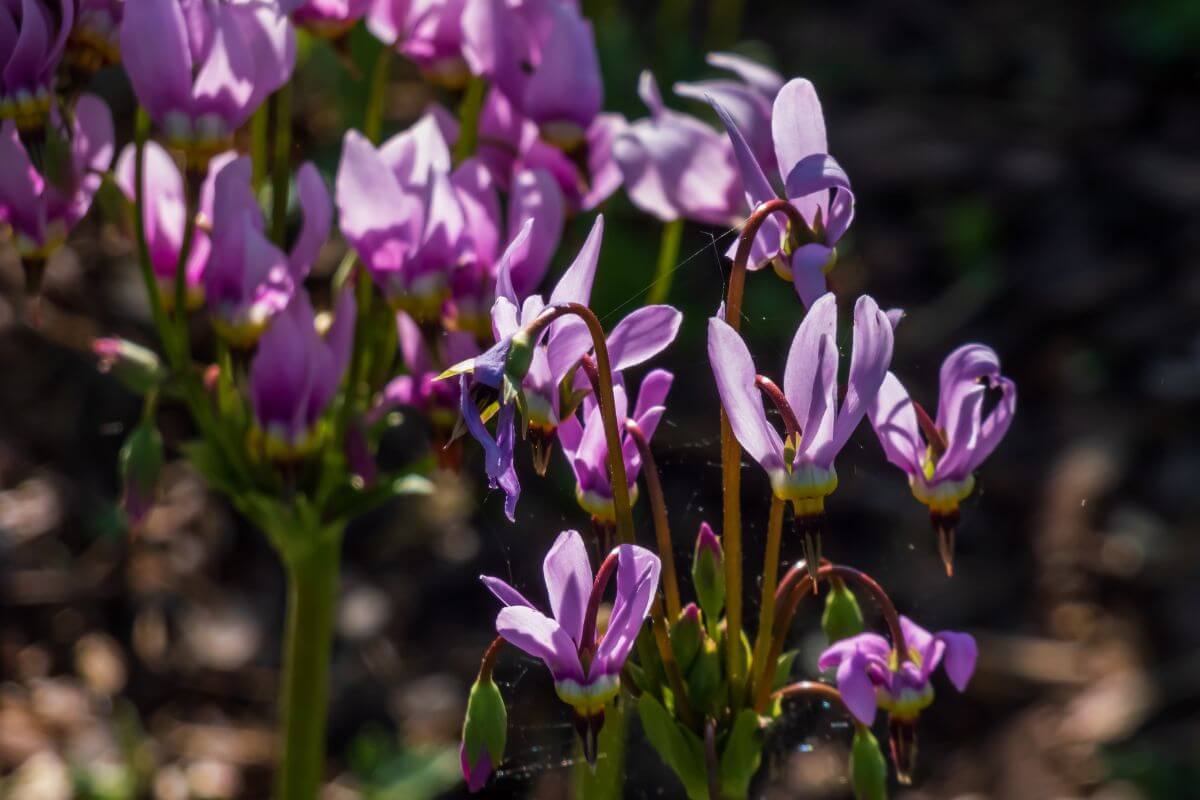
| Attribute | Description |
| Common Name | Shooting Star |
| Scientific Name | Dodecatheon spp. |
| Growth Type | Perennial |
| Flower Stem Height | Ranges from 5-40 cm tall |
One of the beautiful wildflowers found in Montana is the shooting star, which includes specific species such as the Pretty Shooting Star (Dodecatheon pulchellum), Jeffrey’s Shooting Star, and the Few-flowered Shooting Star.
These different species of shooting stars contribute to the diverse wildflower population in Montana, enhancing the state’s natural beauty and ecological richness. With their unique features and vibrant colors, shooting stars are a delightful addition to Montana’s floral landscape.
3. Chicory
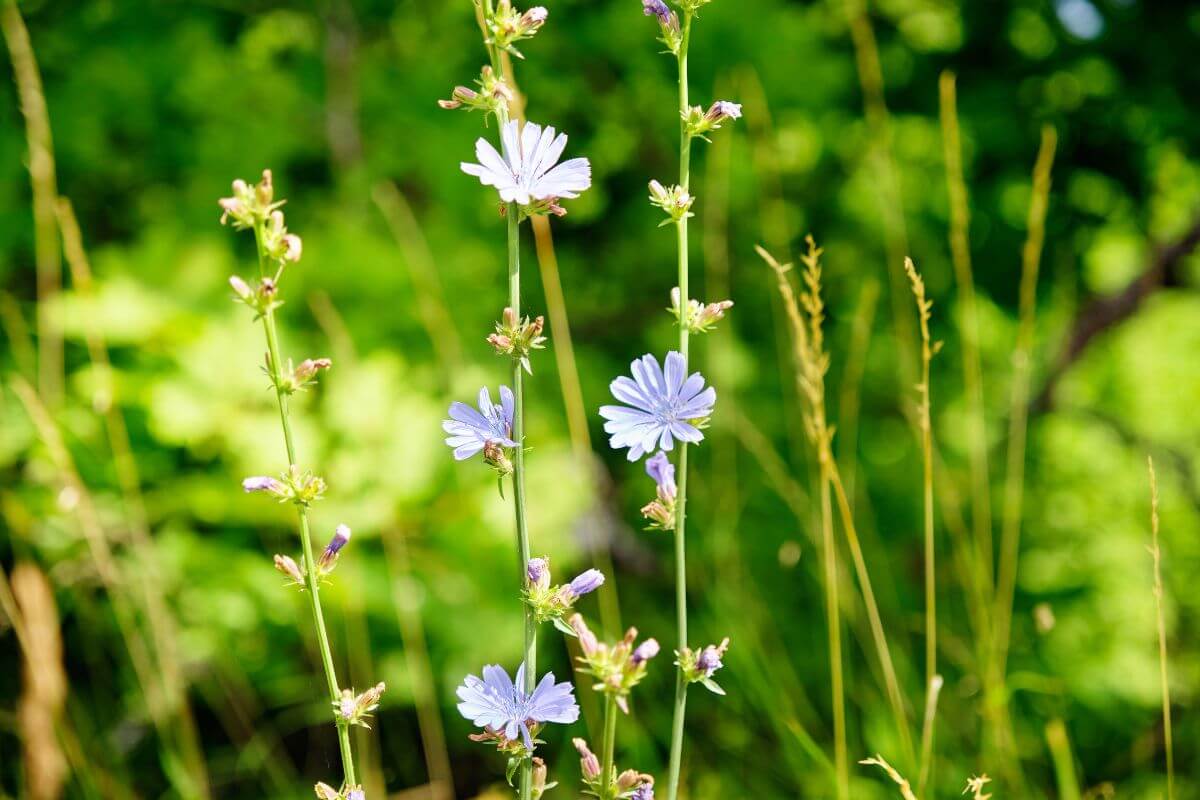
| Attribute | Description |
| Scientific Name | Cichorium intybus |
| USDA Hardiness | Zones 3-10 |
| Mature Size | 1-4 feet |
| Bloom Time | Summer and Fall |
| Sun Exposure | Full Sun |
Chicory is a common wildflower found throughout Montana, particularly in sunny and dry areas along roadsides and open fields. Despite being non-native, it has become well-established in the state’s landscape.
One interesting feature of Chicory is its flowers, which bloom for only one day. In hot weather conditions, the flowers may open for just a few hours before closing again. This ephemeral blooming cycle adds to the charm and intrigue of this wildflower.
An interesting fact about Chicory is that its flowers bloom for only one day, and in hot weather, the flowers may only be open for a few hours. This adds to the allure of this wildflower and makes it a notable addition to the Montana landscape.
4. Blue Vervain
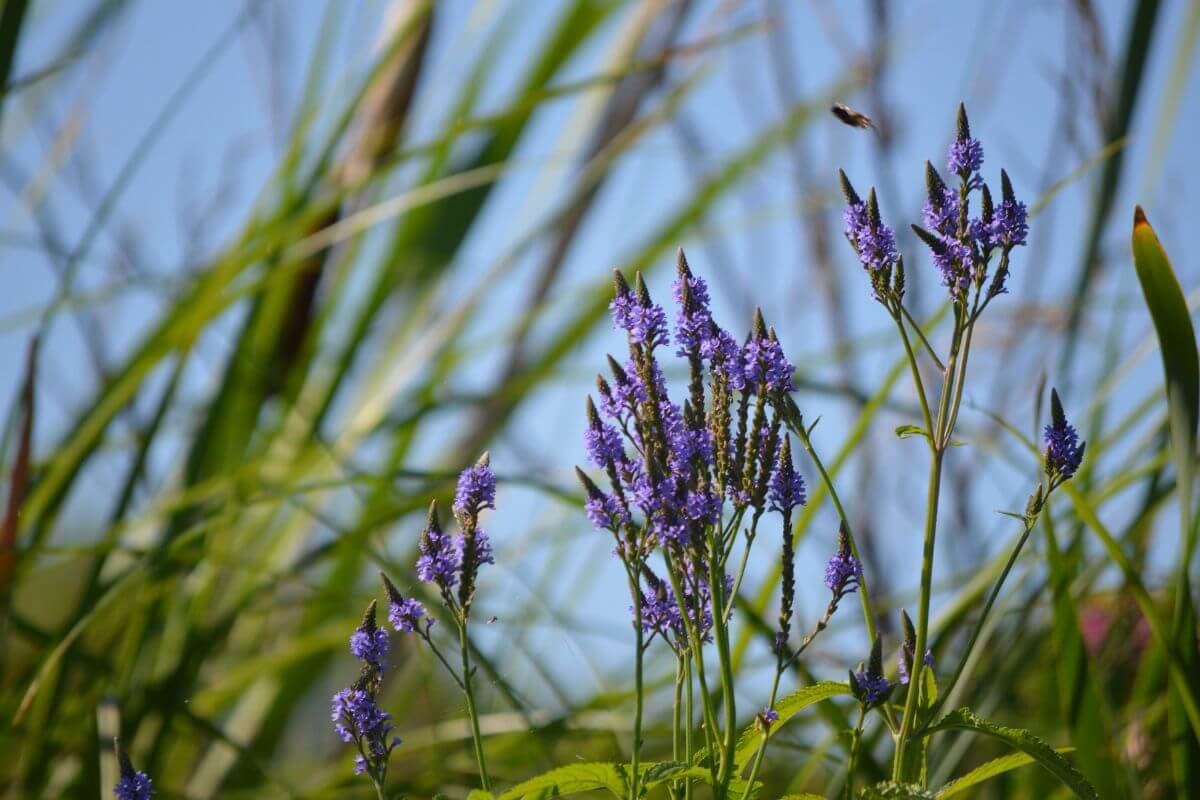
| Attribute | Description |
| Plant Type | Perennial |
| USDA Hardiness | Zones 3-9 |
| Mature Height | 2-5 feet |
| Bloom Time | Early Summer to Fall |
| Scientific Name | Verbena hastata |
| Common Names | Blue Vervain, American Vervain, Swamp Verbena |
| Habitat | Plains, Foothills, Wet Soils, Ditches, Shores, Wet Fields |
| Special Features | Hardy, Drought-Resistant |
Blue Vervain attracts a diverse array of pollinators, including native bees, honeybees, beneficial wasps, small butterflies, skippers, and moths. It serves as a host plant for the Verbena Moth and the Common Buckeye Butterfly caterpillars, providing essential food and habitat for these species.
5. Common Blue Violet
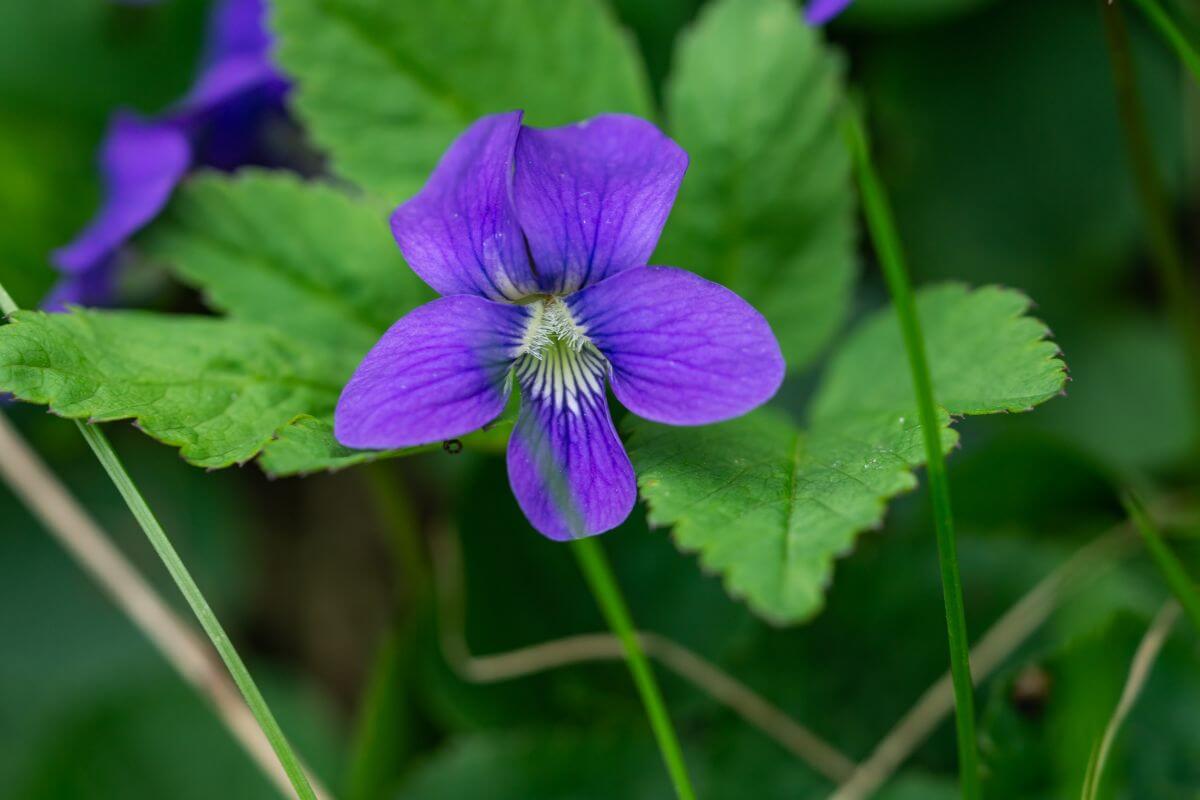
| Attribute | Description |
| Scientific Name | Viola sororia |
| Common Names | Common Blue Violet, Common Meadow Violet, Purple Violet, Woolly Blue Violet, Hooded Violet, Wood Violet |
| Plant Type | Perennial |
| USDA Hardiness | Zones 3-10 |
| Mature Size | 6-10 inches |
| Bloom Time | Mid-Spring to Late Summer |
An interesting fact about the common blue violet is that it can self-fertilize inside the plant without opening. Its unique seed dispersal mechanism involves seed capsules eventually turning upright, opening, and shooting out their seeds as far as 9 feet away from the plant.
6. Common Periwinkle
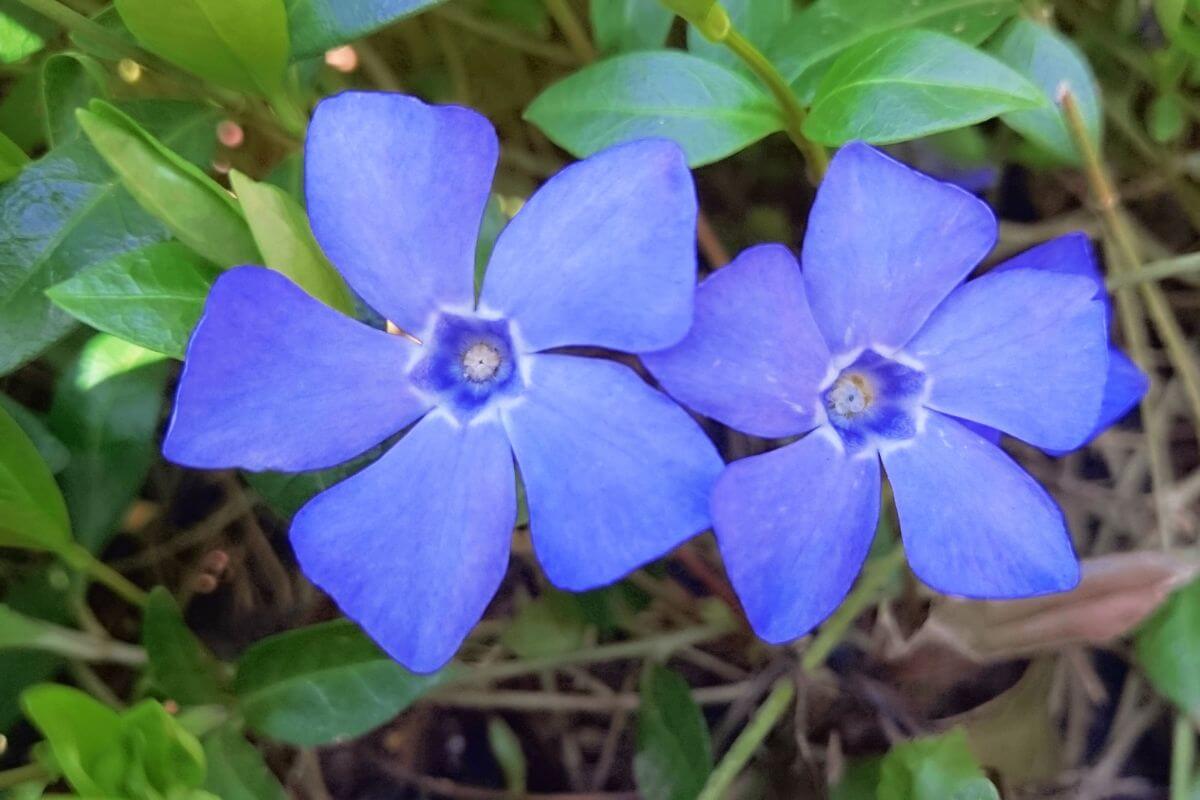
| Attribute | Description |
| Scientific Name | Vinca minor |
| Common Names | Common Periwinkle, Lesser Periwinkle, Dwarf Periwinkle |
| Plant Type | Perennial |
| USDA Hardiness | Zones 4-9 |
| Mature Size | 4-6 inches |
| Bloom Time | Year-round |
| Sun Exposure | Full sun, partial sun, shade |
While not a native wildflower to North America, the common periwinkle still attracts pollinators such as bumblebees, Anthophorid Bees, Mason Bees, and bee flies.
In Montana, the common periwinkle is commonly used as a ground cover. Its benefit lies in being deer-resistant, making it a valuable addition to landscapes where deer may be a concern.
7. Teasel
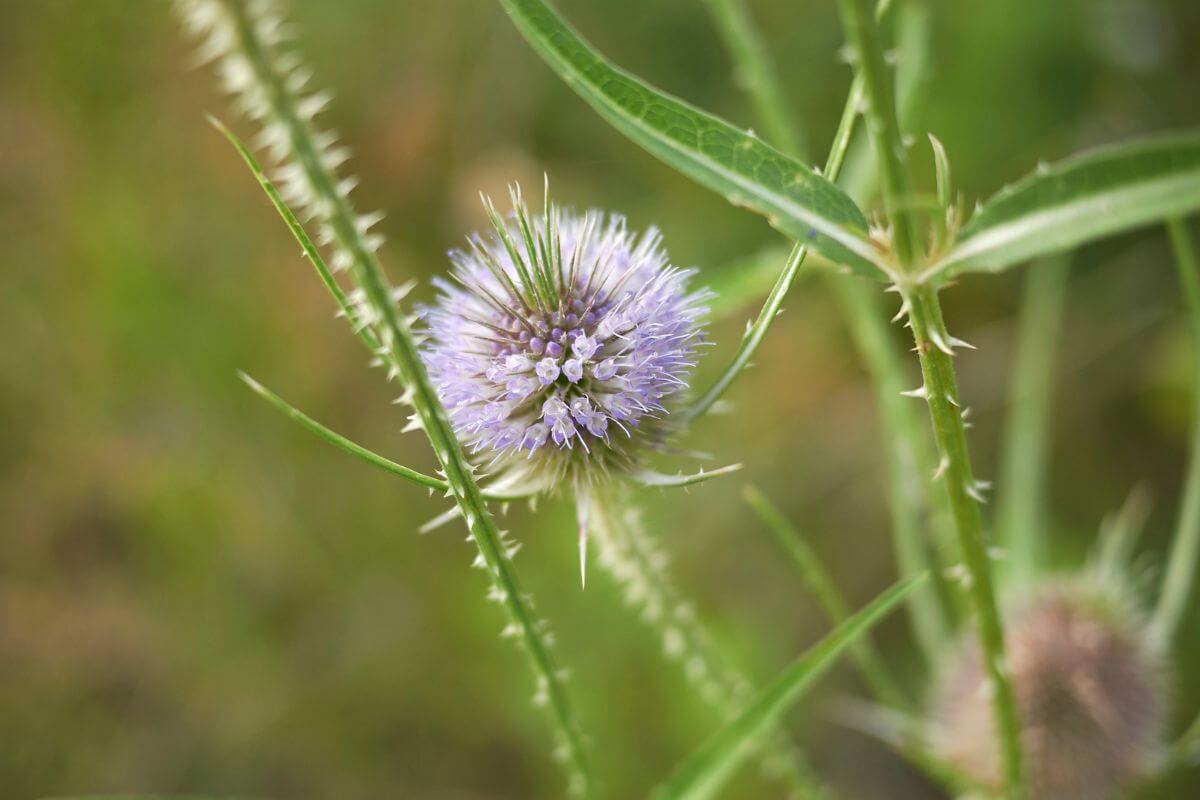
| Attribute | Description |
| Common Name | Teasel |
| Scientific Name | Dipsacus fullonum |
| Growth Type | Biennial |
| Hardiness Zones | USDA Zones 3-8 |
| Mature Height | 4-6 feet |
| Blooming Period | Summer to fall |
| Flower Color | Purplish-blue |
| Sun Exposure | Full sun to partial shade |
| Notable Characteristics | Prickly stem and leaves, attracts pollinators, and adds color and texture to the landscape |
The Teasel’s seeds are favored by goldfinches, offering essential winter sustenance. This relationship underscores its ecological importance in supporting local bird populations.
Teasel is valued in traditional medicine for its kidney tonic properties and ability to aid in healing connective tissue. Its potential in treating Lyme disease symptoms underscores its medicinal value.
It is a botanical marvel in Montana, offering beauty, ecological support, and medicinal potential. Appreciating and preserving its role in the ecosystem is crucial for the well-being of both wildlife and humans.
8. Forget-Me-Not
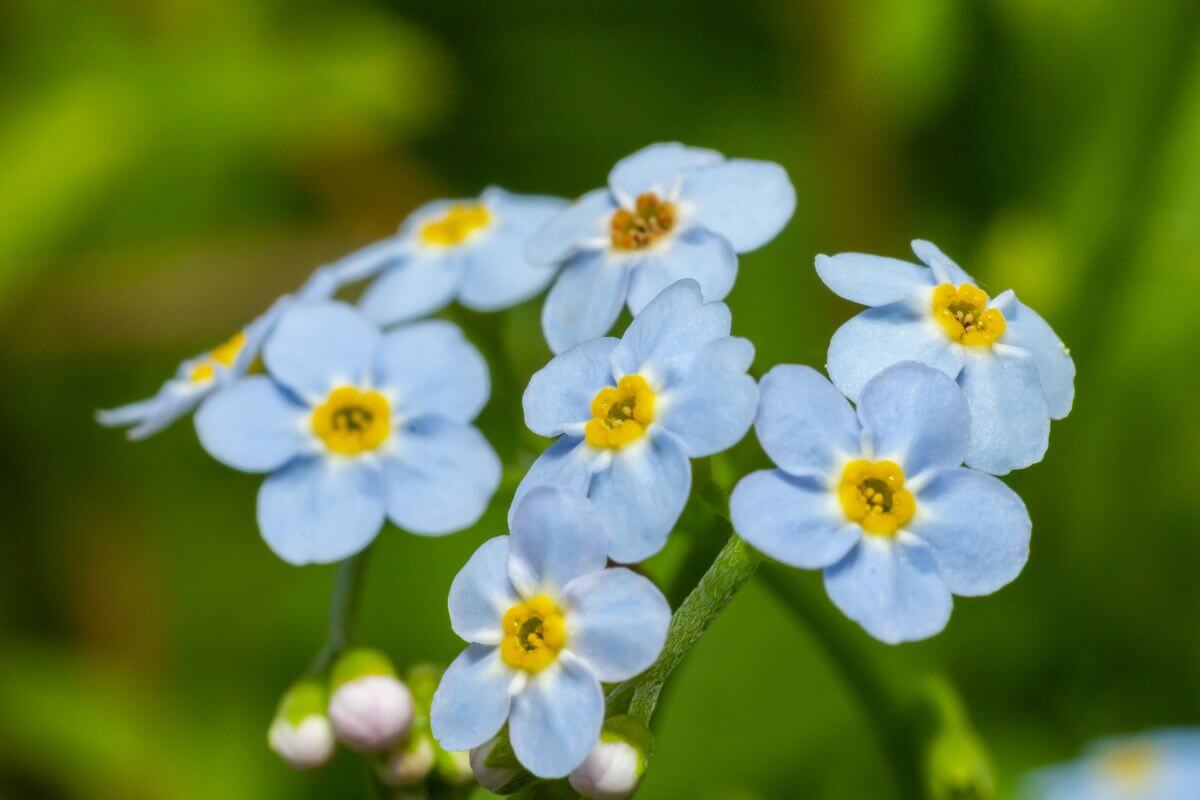
| Attribute | Description |
| Common Name | Forget-me-not |
| Scientific Name | Myosotis scorpioides |
| Growing Information | Perennial, USDA Hardiness Zones 5-9, Mature Size: 6-12 inches, Blooms in Spring, Summer, and Fall, Tolerates Full Sun and Partial Sun Exposures |
| Unique Features | Coiled flower stalks resembling the tail of a scorpion, Alternative Name: Scorpion Weed, Speculation about the common name related to unpleasant taste or odor |
Forget-me-not is a perennial plant in Montana, also known as Water Forget-me-not, True Forget-me-not, Love-me, Mouse-ear, Mouse-ear Scorpion Grass, Scorpion Weed, and Snake Grass.
These plants have a propensity for rapid seed spread, often sprouting unexpectedly. Fortunately, forget-me-nots can be easily moved by digging them up and replanting, as they are not bothered by relocation.
These tiny, sky-blue flowers can be found in alpine meadows and rocky slopes at higher elevations such as the iconic Glacier National Park.
It’s encouraged not to destroy forget-me-nots, as they attract butterflies, bees, and moths, contributing to local biodiversity and pollination efforts. Their presence adds to the beauty and ecological diversity of Montana’s landscapes.
9. Bachelor’s Button
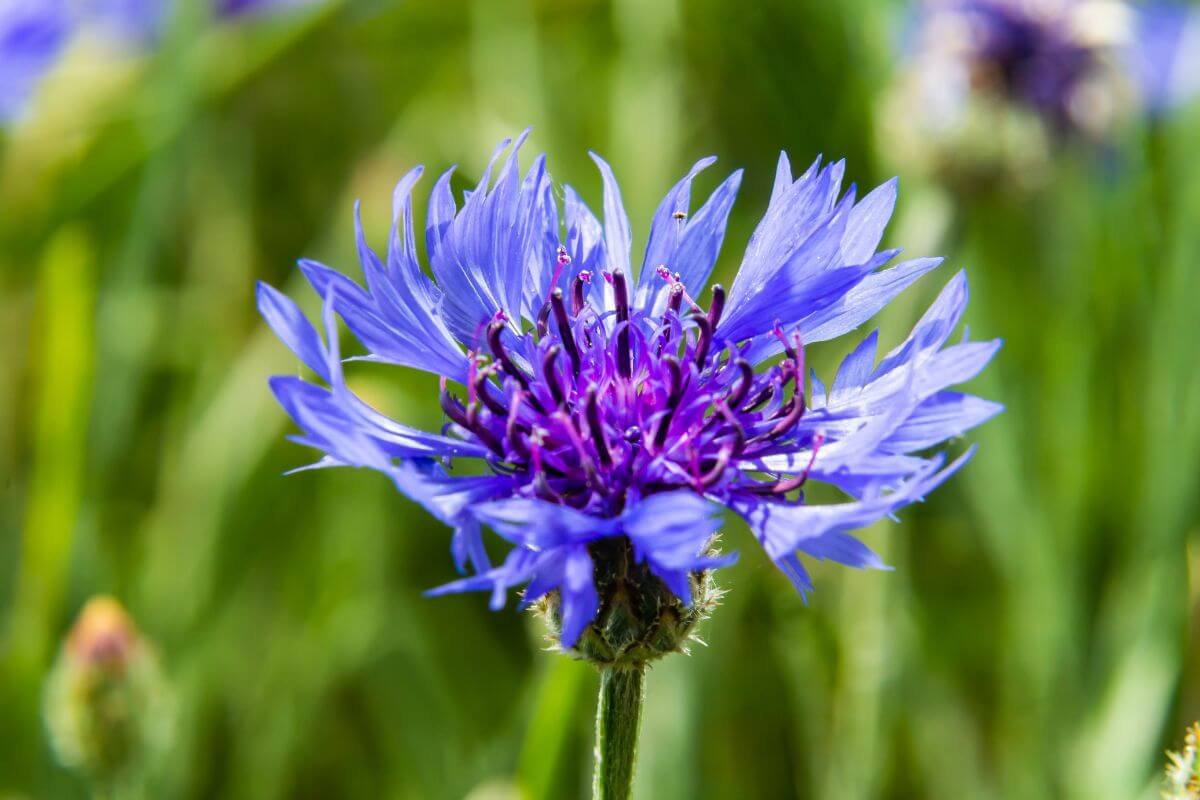
| Attribute | Description |
| Common Name | Bachelor’s Button |
| Scientific Name | Centaurea cyanus |
| Growing Information | Annual, USDA Hardiness Zones 2-4, Mature Size: 1-3 feet, Blooms from Late Spring to Late Summer, Thrives in Full Sun to Light Shade |
| Unique Features | Favorite among butterflies, Ideal for cutting and drying, Virtually pest and disease-free, Low-maintenance, Deer and drought-tolerant |
This easy-to-grow plant is recommended for borders of flower beds or rock gardens, adding a pop of vibrant blue to the landscape. With its adaptability to Montana’s climate and its attractiveness to butterflies, the bachelor’s button is a lovely addition to any garden in the region.
10. Bull Thistle
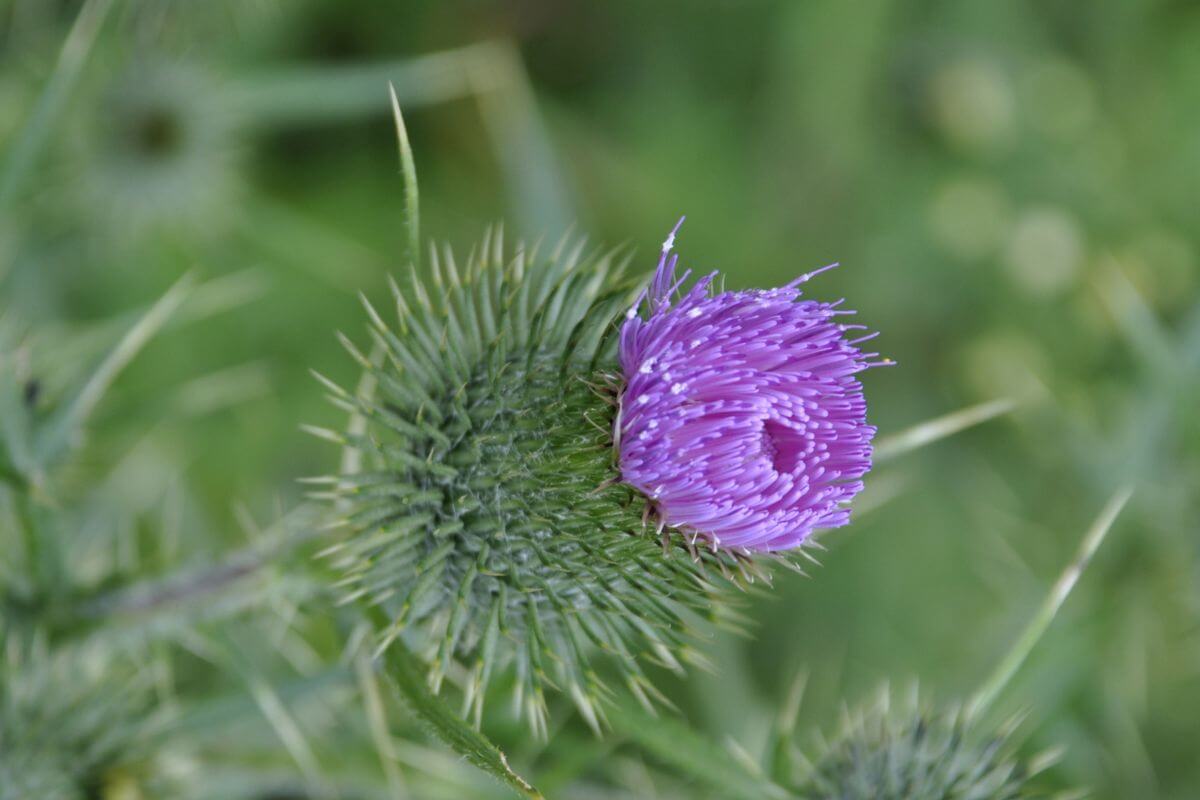
| Attribute | Description |
| Common Name | Bull Thistle |
| Scientific Name | Cirsium vulgare |
| Growing Information | Biennial, USDA Hardiness Zones 3a-8b, Mature Height: 2-6′, Blooms in Summer and Fall, Prefers Full Sun to Sun/Partial Shade |
Bull thistle is a common sight in the state, but it is important to handle it with caution due to its spiny nature. Despite its prickly exterior, it is a valuable plant for wildlife. The seeds of bull thistle are a favorite food source for goldfinches, and the downy fluff from the seed heads is used by birds to line their nests, particularly in late summer.
Giant bees and butterflies are attracted to bull thistle, making it an excellent choice for those seeking to attract pollinators to their garden. Its vibrant purple blooms add a pop of color to the landscape while providing essential resources for local wildlife.
11. Common Burdock
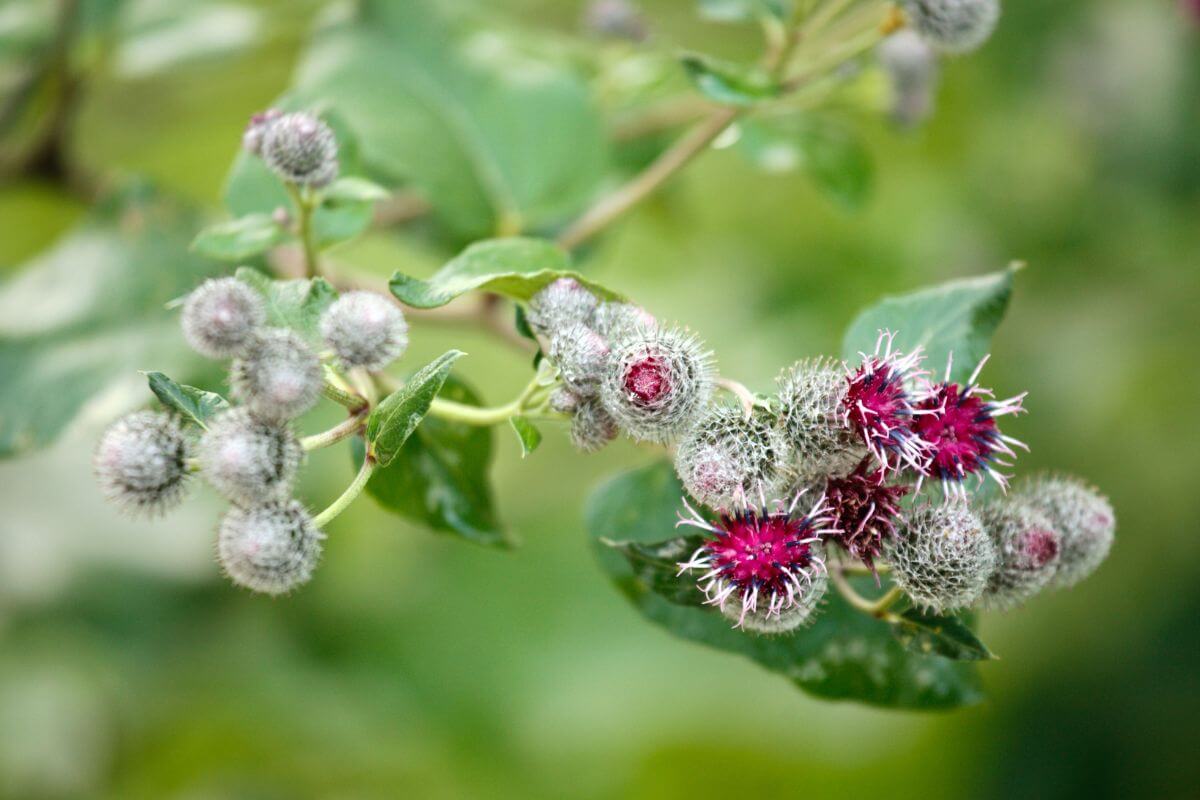
| Attribute | Description |
|---|---|
| Common Name | Common Burdock |
| Scientific Name | Arctium minus |
| Growing Information | Biennial, USDA Hardiness Zones 4a-10b, Mature Size: 4-6′, Blooms Mid-Summer to Mid-Fall, Prefers Sun to Partial Shade |
| Habitat | Pastures, Open Prairies, Hayfields, Roadsides, Old Fields, Barnyards, Railways, Disturbed Areas |
| Seed Dispersal | Dried Flower Heads with Velcro-like Characteristics for Seed Transportation |
Common burdock is a purple wildflower, also known as lesser burdock, little burdock, louse-bur, button-bur, cuckoo-button, and wild rhubarb. The wildflower attracts bees, butterflies, and birds, contributing to local biodiversity.
Handling the plant should be done with caution, as it may cause skin irritation or an allergic reaction. Despite its attractive features and benefits to wildlife, care should be taken when coming into contact with common burdock.
12. Clasping Venus’ Looking Glass
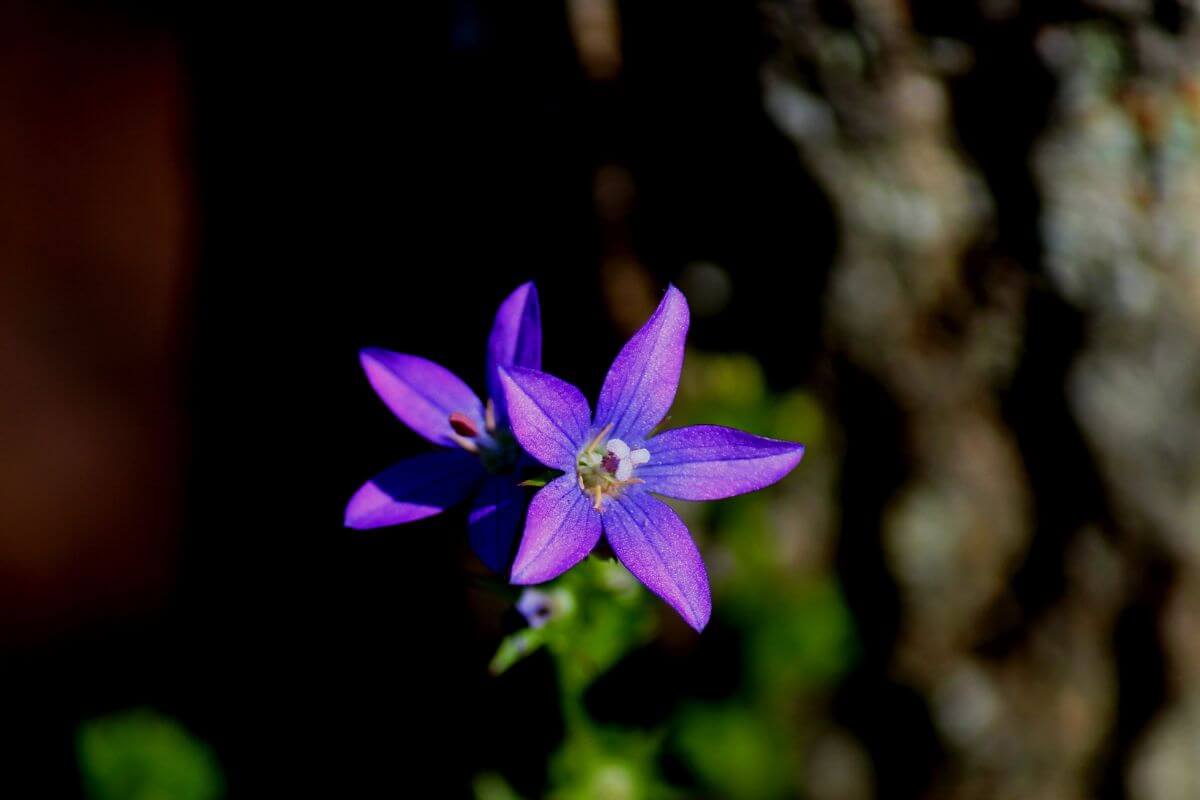
| Attribute | Description |
|---|---|
| Common Name | Clasping Venus’ Looking Glass, Roundleaf Triodanis, Clasping Bellflower |
| Scientific Name | Triodanis perfoliata |
| Growing Information | Annual, USDA Hardiness Zones: 2-11, Mature Height: 6-36 inches, Blooms in Spring and Summer, Thrives in Full Sun |
Clasping Venus’ Looking Glass can commonly be found in dry sandy soils in disturbed areas, gardens, and woods. Its distinctive feature includes flowers that bloom in rounded leaves, making it relatively easy to identify. This plant can self-pollinate and is attractive to small butterflies, bees, and flies.
Clasping Venus’ Looking Glass is an attractive addition to any garden, and its ability to thrive in a variety of conditions makes it a versatile and popular choice for many gardeners.
13. Bee Balm
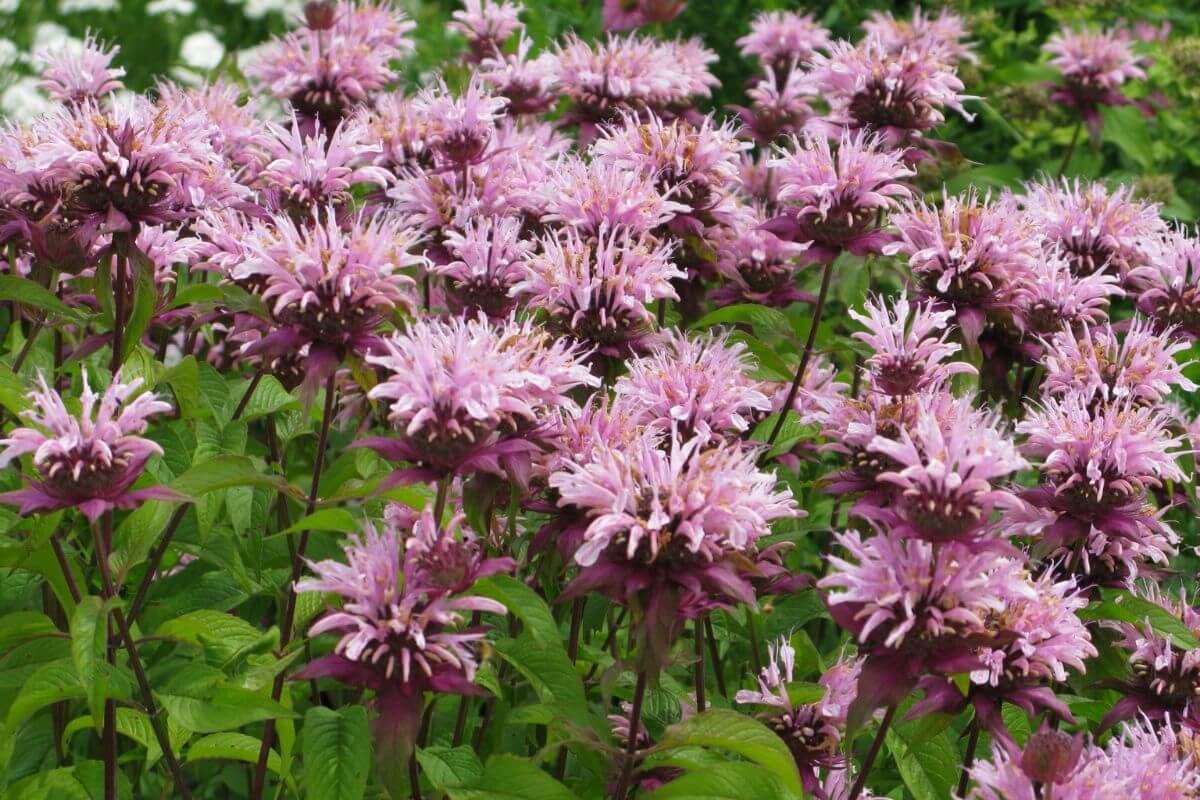
| Attribute | Description |
|---|---|
| Common Name | Bee Balm |
| Scientific Name | Monarda fistulosa |
| Growing Information | Perennial, USDA Hardiness Zones: 3a-9b, Mature Height: 2-4 feet, Blooms in Summer, Thrives in Sun to Partial Shade, Commonly found in dry areas of fields, prairies, and along roads in Montana |
The approximate mature size of Bee Balm is 2-4 feet, and it typically blooms in the summer. This plant thrives in sun to partial shade and is commonly found in dry areas of fields, prairies, and along roads in Montana.
One of the primary reasons for growing Bee Balm is to attract hummingbirds, butterflies, and pollinator bees. The beautiful lilac-purple blooms of Bee Balm are irresistible to these creatures, potentially reducing the need for hummingbird feeders.
Bee Balm leaves can be used to make a refreshing tea with antimicrobial properties, providing health benefits such as warding off colds and the flu.
It is a stunning perennial with nectar-rich flowers that are highly attractive to birds and insects. Its ability to attract beneficial wildlife and its potential health benefits make it a valuable addition to any garden.
14. Creeping Charlie
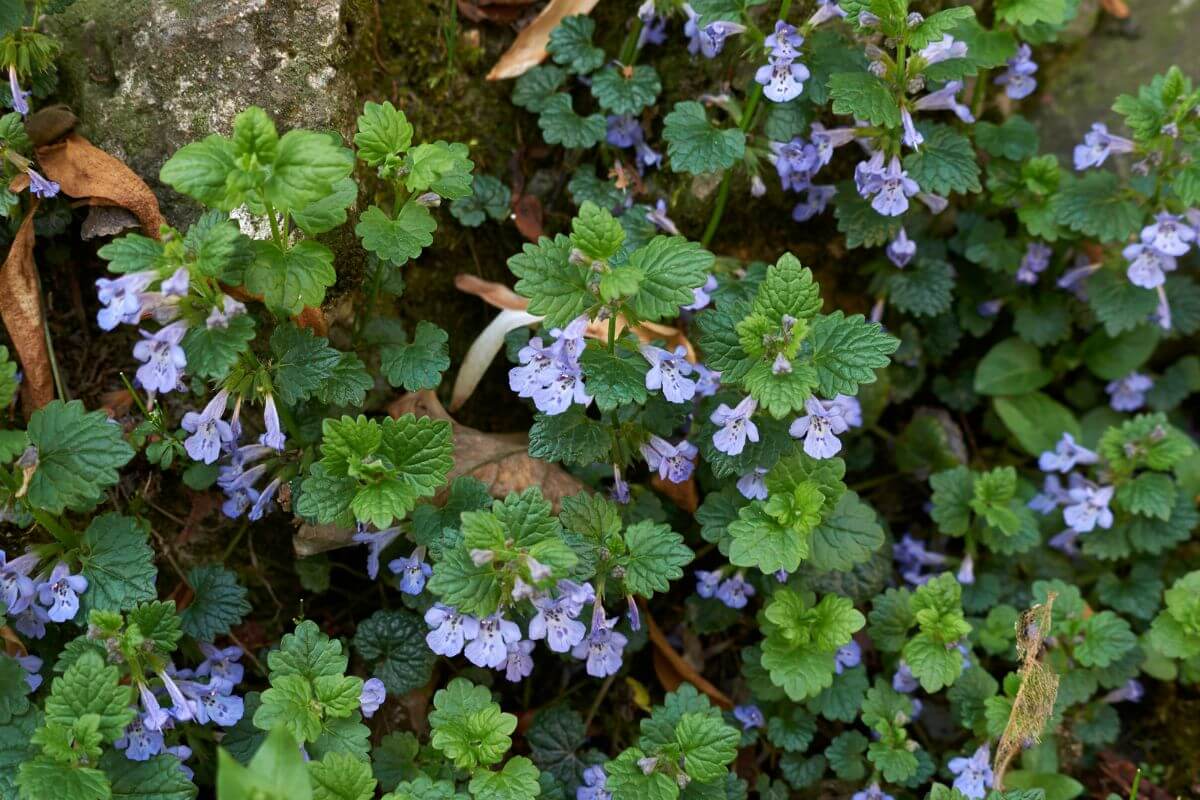
| Attribute | Description |
|---|---|
| Common Name | Creeping Charlie, Ground Ivy |
| Scientific Name | Glechoma hederacea |
| Growing Information | Perennial, USDA Hardiness Zones: 3a-10b, Mature Size: 5-8 inches, Blooms in Spring and Summer, Thrives in Sun to Partial Shade |
In its natural habitat, Creeping Charlie grows in large groups in moist semi-shaded areas and is tolerant of the sun. Bees are attracted to the plant for collecting pollen, making it a beneficial addition to a garden.
Creeping Charlie is often considered a weed and is commonly found in lawns. Battling this invasive plant can be challenging due to its extensive root system, which makes hand-pulling or mowing ineffective.
While Creeping Charlie may be attractive to bees, its aggressive growth and difficulty to control make it a nuisance for many homeowners.
15. Purple Loosestrife
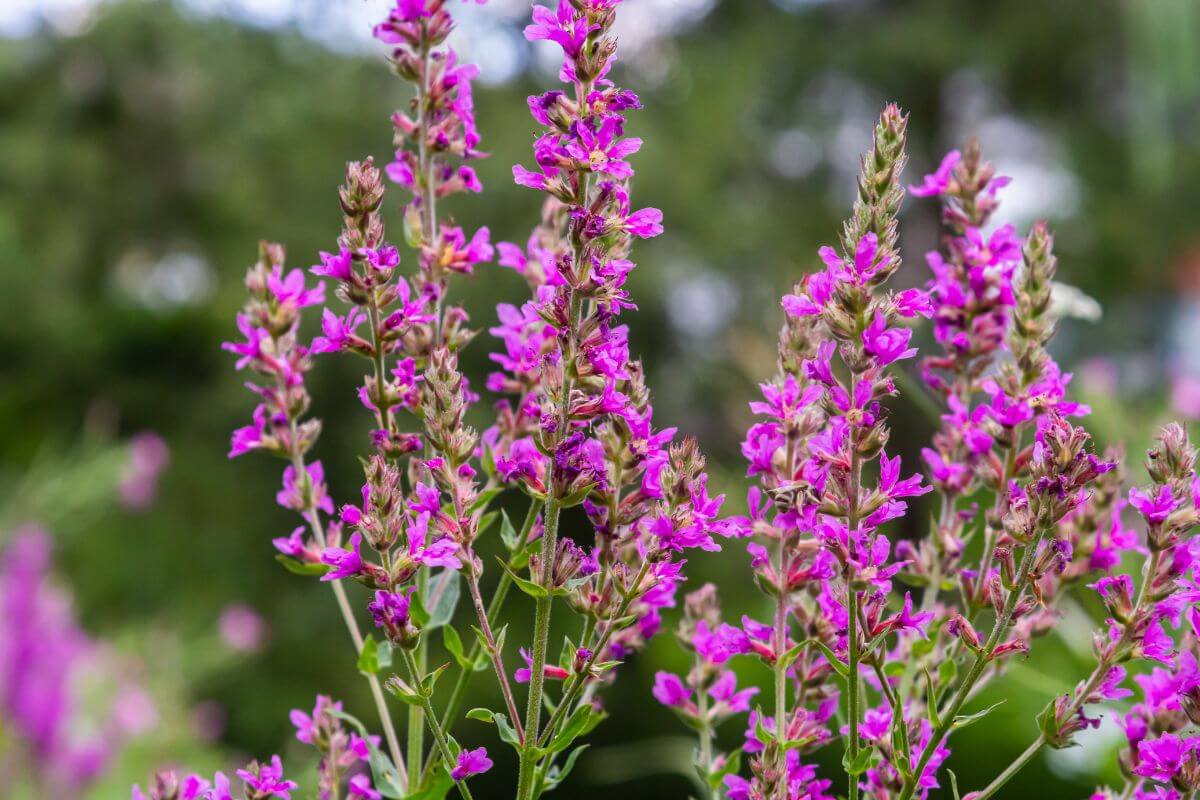
| Attribute | Description |
|---|---|
| Common Name | Purple Loosestrife, Spiked Loosestrife, Purple Lythrum |
| Scientific Name | Lythrum salicaria |
| Growing Information | Perennial, USDA Hardiness Zones: 3a-9b, Mature Height: 2-5 feet, Blooms in Summer, Requires Full Sun |
- Habitat – Purple loosestrife is commonly found in wet areas such as wet meadows, marshes, and along lakeshores.
- Invasive Nature – Unfortunately, purple loosestrife’s invasive nature poses a significant threat to native plants. It can quickly take over and displace them. Each flower spike has the potential to produce up to 300,000 seeds, contributing to its rapid reproduction. The plant can spread through new shoots growing from its roots, further aiding in its expansion.
- Conservation Concerns – Due to its invasive tendencies, purple loosestrife is a concern for conservationists and environmentalists. Efforts are often made to control its spread and mitigate its impact on native ecosystems.
Despite its beauty, it is important to be mindful of its potential to disrupt the balance of natural habitats.
16. Dame’s Rocket
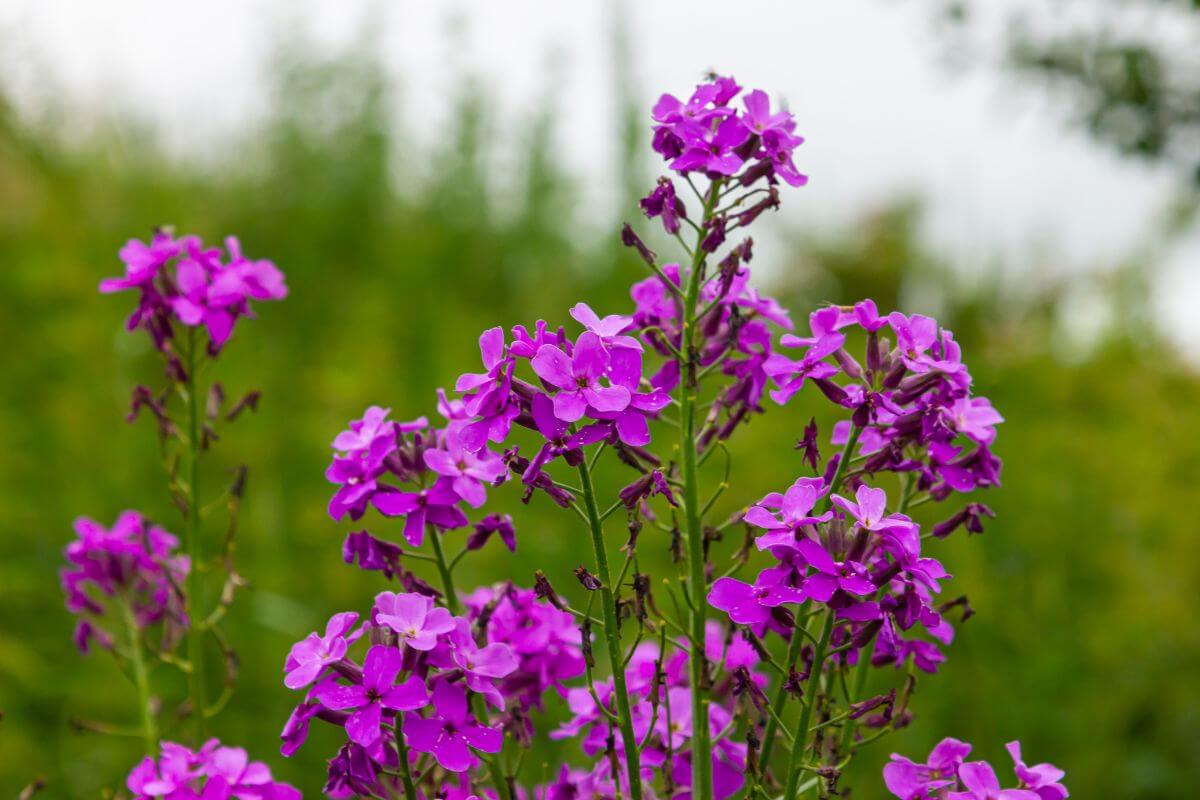
| Attribute | Description |
|---|---|
| Common Name | Dame’s Rocket, Damask-violet, Dame’s-violet, Dames-wort |
| Scientific Name | Hesperis matronalis |
| Growing Information | Biennial or short-lived perennial, USDA Hardiness Zones: 3-9, Blooms in Early to Mid-Spring, Prefers Full Sun to Partial Shade, Found in meadows and woodlands |
| Mature Size | 1-4 feet |
Dame’s Rocket is often included in prepackaged “wildflower seed” mixes, making it a common sight in gardens and natural landscapes. While Dame’s Rocket is considered invasive in some areas, it also has positive qualities. They prefer full sun to partial shade and can be found throughout Montana, particularly in meadows and woodlands.
The young leaves are high in Vitamin C and have a slightly bitter taste, making them a unique addition to salads or other dishes. Its sweet, fragrant flowers make it an attractive choice for gardeners looking to add a pop of purple to their landscape.
Dame’s Rocket is a versatile and widespread wildflower that offers both beauty and potential culinary benefits. Despite its invasiveness in certain regions, its ability to thrive in various environments and its edible qualities make it a valuable addition to any landscape.
17. Heal-All
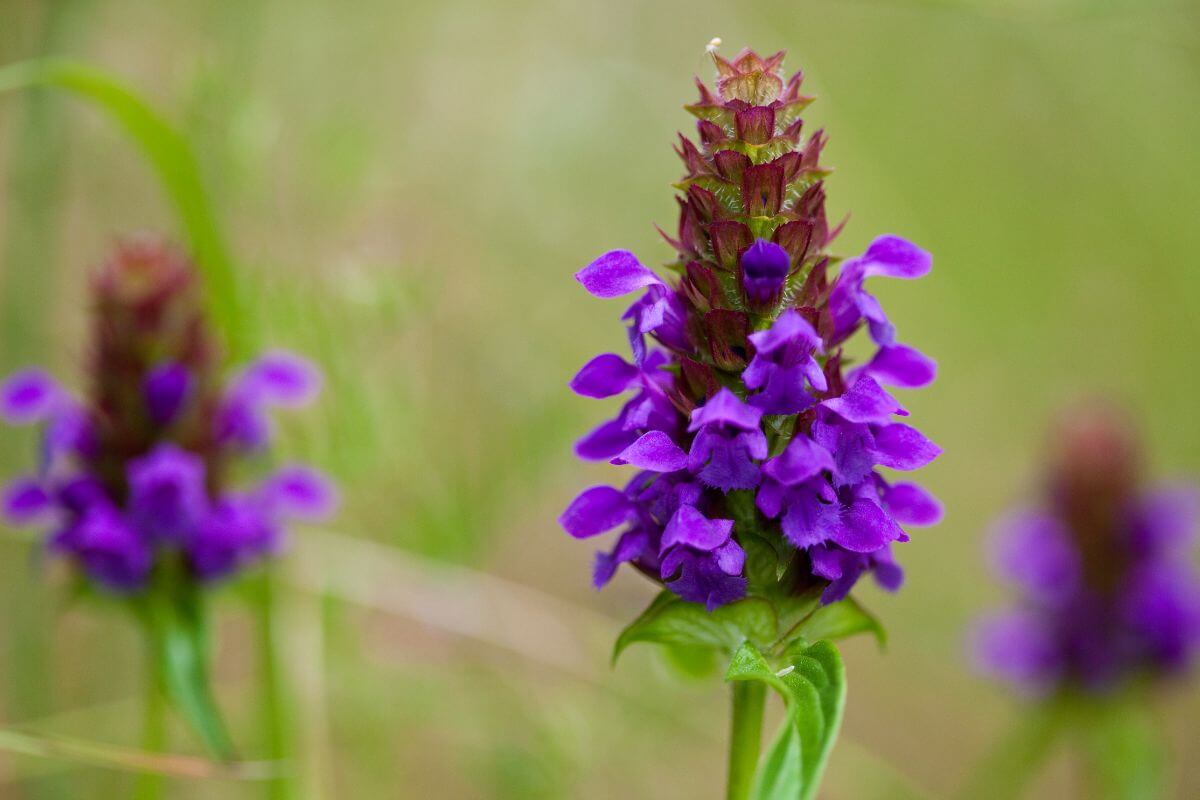
| Attribute | Description |
|---|---|
| Common Name | Heal-all, Common Self-heal, Woundwort, Heart-of-the-earth, Carpenter’s Herb, Brownwort, Blue Curls |
| Scientific Name | Prunella vulgaris |
| Growing Information | Perennial, USDA Hardiness Zones: 4-9, Blooms from Late Spring to Late Fall, Does Well in Sun to Partial Shade |
| Mature Size | 6-12 inches |
Heal-all is one of the most common wildflowers, often found in lawns, along roadsides, and on the edge of woodlands. It can be quite aggressive in large grassy areas but is a favorite among butterflies, bees, and other pollinators, making it a suitable ground cover for border fronts, meadows, and naturalized landscapes.
This versatile plant adds beauty and attracts beneficial insects, making it a valuable addition to any garden or natural setting. Its robust nature and ability to thrive in various conditions have made it a popular choice for both experienced and novice gardeners.
With its lovely blue wildflowers and ability to attract pollinators, heal-all is a welcome sight in the wild and cultivated spaces alike, contributing to the diversity of plant and insect species.
18. Swamp Milkweed
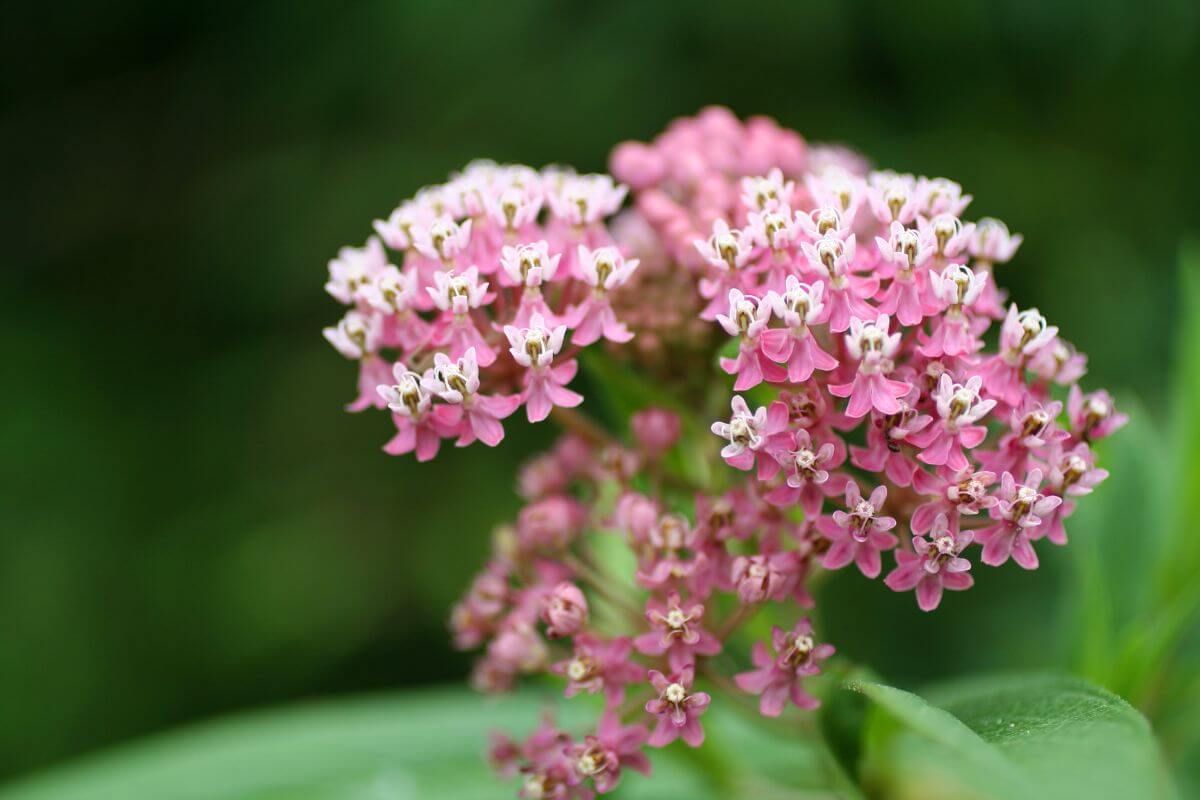
| Attribute | Description |
|---|---|
| Common Name | Swamp Milkweed, Pink Milkweed |
| Scientific Name | Asclepias incarnata |
| Growing Information | Perennial, Well-suited for USDA Hardiness Zones: 3-11, Thrives in Wet Meadows and Along Lakeshores |
| Mature Size | 24-72 inches tall |
| Blooming Season | Summer to Fall |
| Sunlight Requirement | Prefers Full Sun to Partial Shade |
One of its key identifying features is its clusters of deep pink flowers, which not only add a splash of color to the garden but also attract a variety of pollinators, including hummingbirds, bees, and butterflies.
Swamp milkweed also plays an essential role in the life cycle of Monarch butterflies. Its leaves are a crucial food source for Monarch caterpillars, making it an important plant for supporting their populations.
Gardeners looking to create a wildlife-friendly garden or a pollinator garden will find swamp milkweed to be an excellent addition.
Its hardiness, beautiful blooms, and role in supporting local wildlife make it a valuable plant for any garden. If looking to promote a healthy ecosystem in the garden and contribute to the conservation of Monarch butterflies, swamp milkweed is an ideal choice.
19. Spreading Dogbane
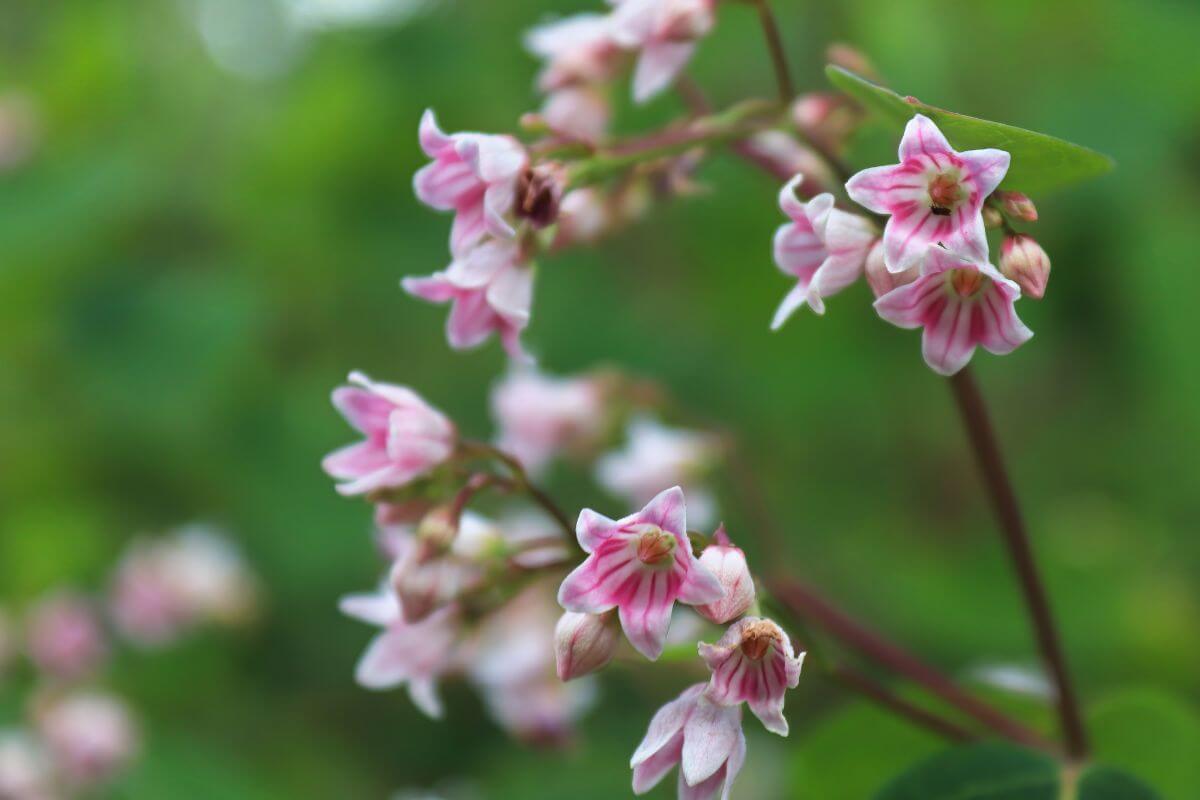
| Attribute | Description |
|---|---|
| Common Name | Spreading Dogbane, Fly-trap Dogbane, Bitterroot |
| Scientific Name | Apocynum androsaemifolium |
| Growing Information | Perennial, Thrives in USDA Hardiness Zones: 2-9, Mature Height: 24-60 inches, Blooms in Summer, Prefers Full Sun to Full Shade |
The name “dogbane” comes from its high toxicity to dogs and humans, making it important to exercise caution around this plant. Spreading Dogbane has small, pink bell-shaped flowers and emits a scent similar to lilac, making it an attractive addition to gardens.
It is commonly found in Montana, especially in sandy soil along stream banks. Spreading Dogbane’s ability to adapt and spread rapidly has made it a common sight in various regions, adding beauty to natural landscapes.
As it is a resilient and hardy plant, Spreading Dogbane can be a valuable addition to gardens and natural areas, providing colorful blooms and interesting foliage while also attracting pollinators.
20. Common Milkweed
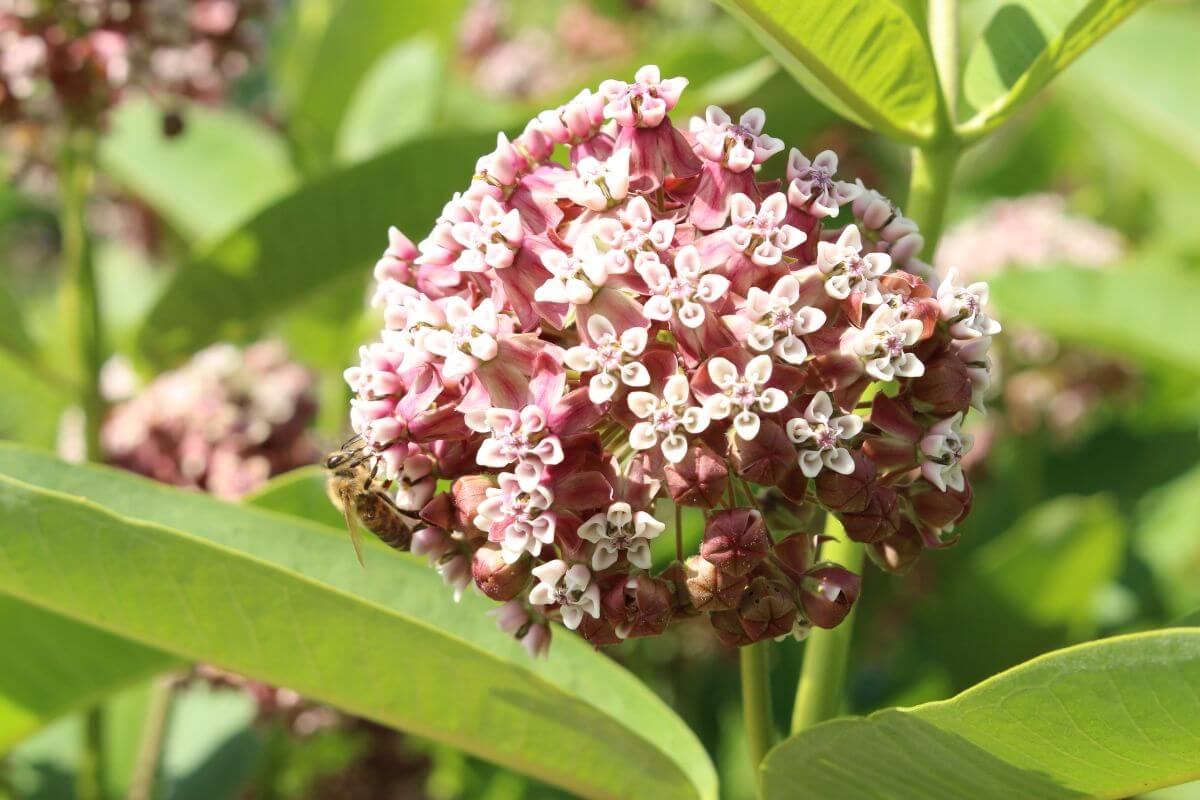
| Attribute | Description |
|---|---|
| Common Name | Common Milkweed |
| Scientific Name | Asclepias syriaca |
| Growing Information | Perennial, Thrives in USDA Hardiness Zones: 3–9a, Mature Size: 36-96 inches tall, Blooms in Summer, Requires Full Sun Exposure |
One of the most significant aspects of common milkweed is its role as a host plant for about 450 species of insects. It is a favorite among pollinators such as beetles, butterflies, moths, bees, wasps, ants, and flies.
It is essential to note that common milkweed has the potential to be invasive, as it can quickly push out and smother other plants. Therefore, if used in a garden, it is best to plant it in an isolated spot with minimal competition.
Common milkweed can be found in various habitats, including abandoned fields, forest clearings, and roadside ditches.
Its ability to attract a wide range of pollinators and its importance as a host plant for numerous insects make common milkweed a valuable addition to any landscape. However, it is crucial to be mindful of its potential to spread rapidly and outcompete other vegetation.
21. Joe Pye Weed
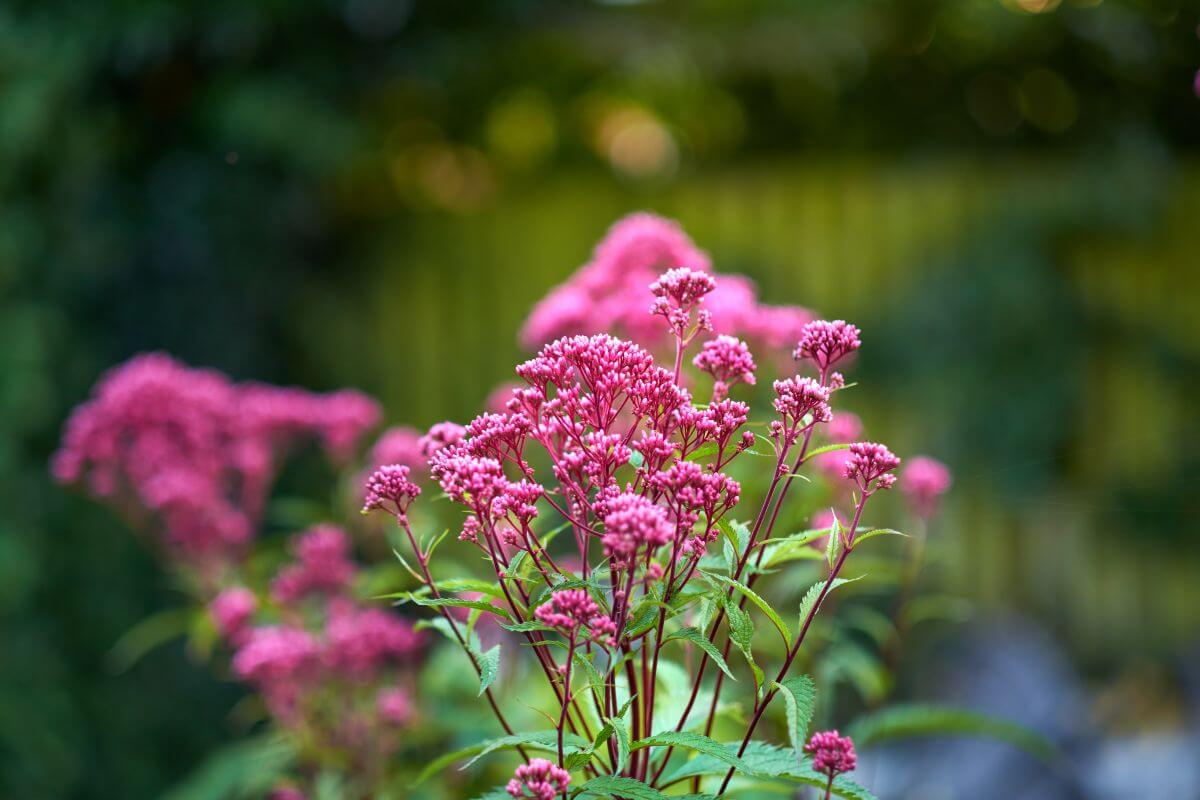
| Attribute | Description |
|---|---|
| Common Name | Joe Pye Weed |
| Scientific Name | Eutrochium spp. (specific species may vary) |
| Growing Information | Perennial, Best suited for USDA Hardiness Zones: 3-9, Mature Size: 24-96 inches tall, Blooms from Summer to Fall, Thrives in Full Sun to Full Shade |
This wildflower naturally grows at the edges of woodlands and wet meadows, thriving best in partial shade. It is also known for its deer-resistant nature.
There are five species of wild Eutrochium found in North America, including Eutrochium dubium, Eutrochium fistulosum, Eutrochium maculatum, Eutrochium purpureum, and Eutrochium steelei, each with its own common name and distribution range.
When shopping for Joe Pye Weed, it is important to note that most options at garden centers will be cultivars of wild varieties. With its beautiful blooms, adaptability, and ability to attract pollinators, Joe Pye Weed is a wonderful addition to any Montana garden, contributing to the beauty and biodiversity of the landscape.
22. Wild Mint
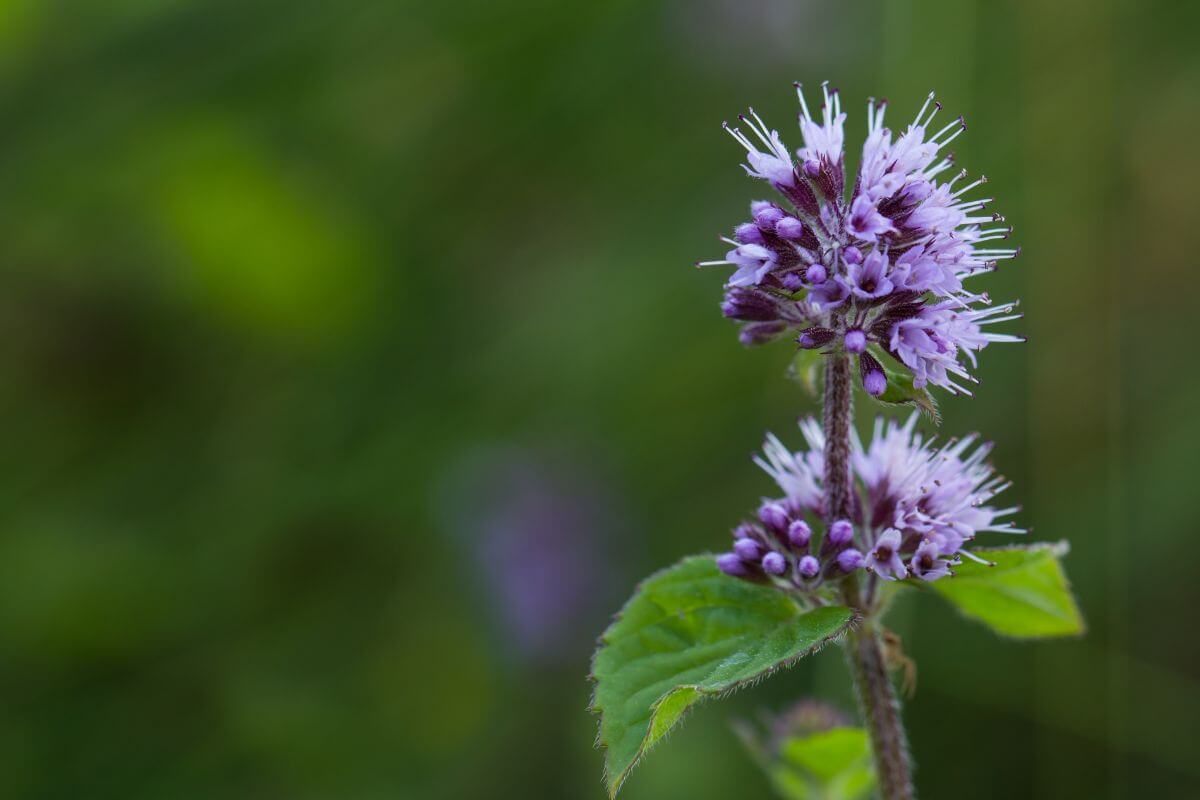
| Attribute | Description |
|---|---|
| Common Name | Wild Mint |
| Scientific Name | Mentha arvensis |
| Growing Information | Perennial, Native to Montana, USDA Hardiness Zones: 4-8, Mature Size: 3.9-39 inches tall |
It blooms in late spring to early summer, displaying dense clusters of lavender, pink, or white bell-shaped flowers. Wild Mint thrives in full sun to light shade, particularly in wetlands with partial sunlight, such as streams and river banks in Montana.
Similar to other mint species, Wild Mint’s fragrance is most potent when the leaves are damaged. This characteristic makes it a delightful addition to any garden, especially for those who appreciate its refreshing scent.
When looking to cultivate Wild Mint, it is important to provide it with moist soil and some sunlight, as it naturally grows in wetland environments. It also tends to spread quickly, so providing ample space for it to grow is essential.
23. Fireweed
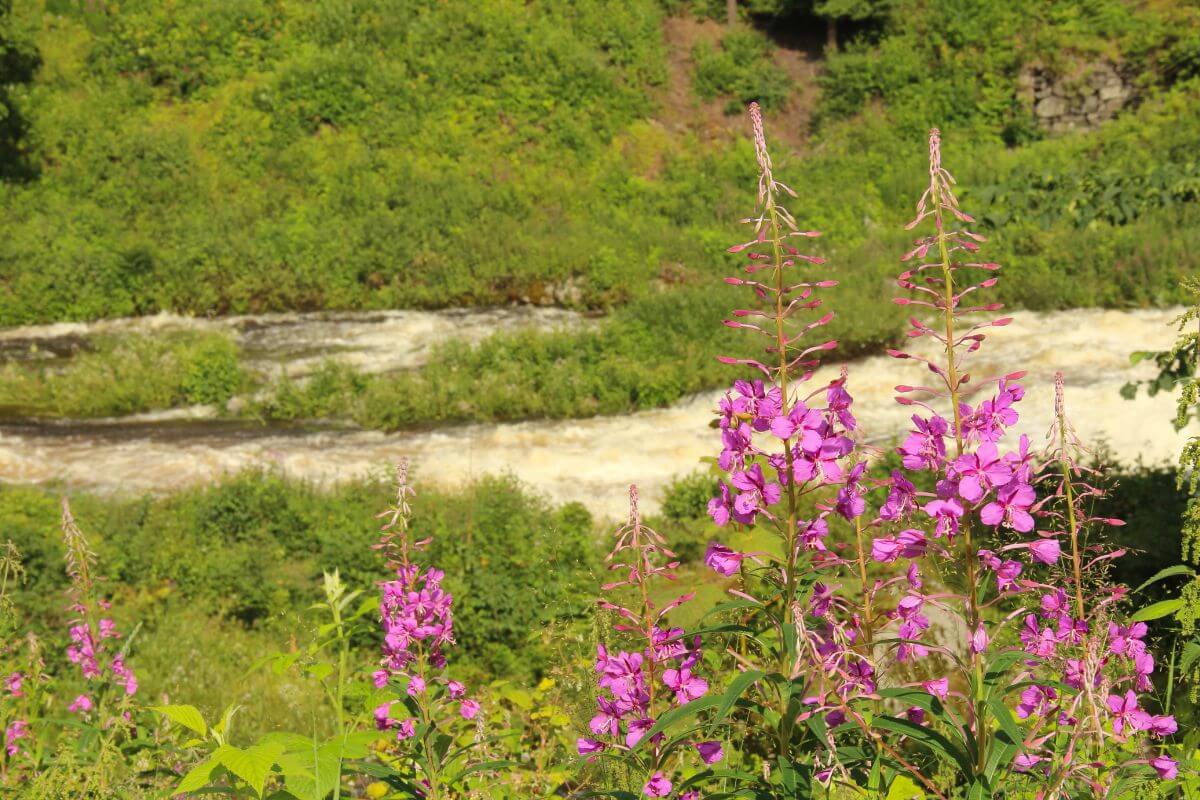
| Attribute | Description |
|---|---|
| Common Name | Fireweed, Willow Herb |
| Scientific Name | Chamerion angustifolium |
| Growing Information | Perennial, Thrives in USDA Hardiness Zones: 2-8, Mature Size: 18-120 inches tall, Blooms in Late Spring and Summer, Prefers Full Sun to Partial Shade |
One of the remarkable qualities of Fireweed is its ability to be the first to grow in clearings recently devastated by forest fires. A notable example of this is its rapid growth in Washington State just one year after the Mount St. Helens eruption in 1980.
Known for its tall spikes of pinkish-purple flowers, fireweed is often one of the first plants to colonize areas after a wildfire and can be found in a variety of habitats famously at Glacier National Park.
This striking plant is recognizable by its spikes of purplish-pink flowers and is known to attract hummingbirds, moths, and butterflies. Fireweed serves as an important source of nectar for these pollinators and adds beauty to the landscape with its vibrant blooms.
24. Everlasting Pea
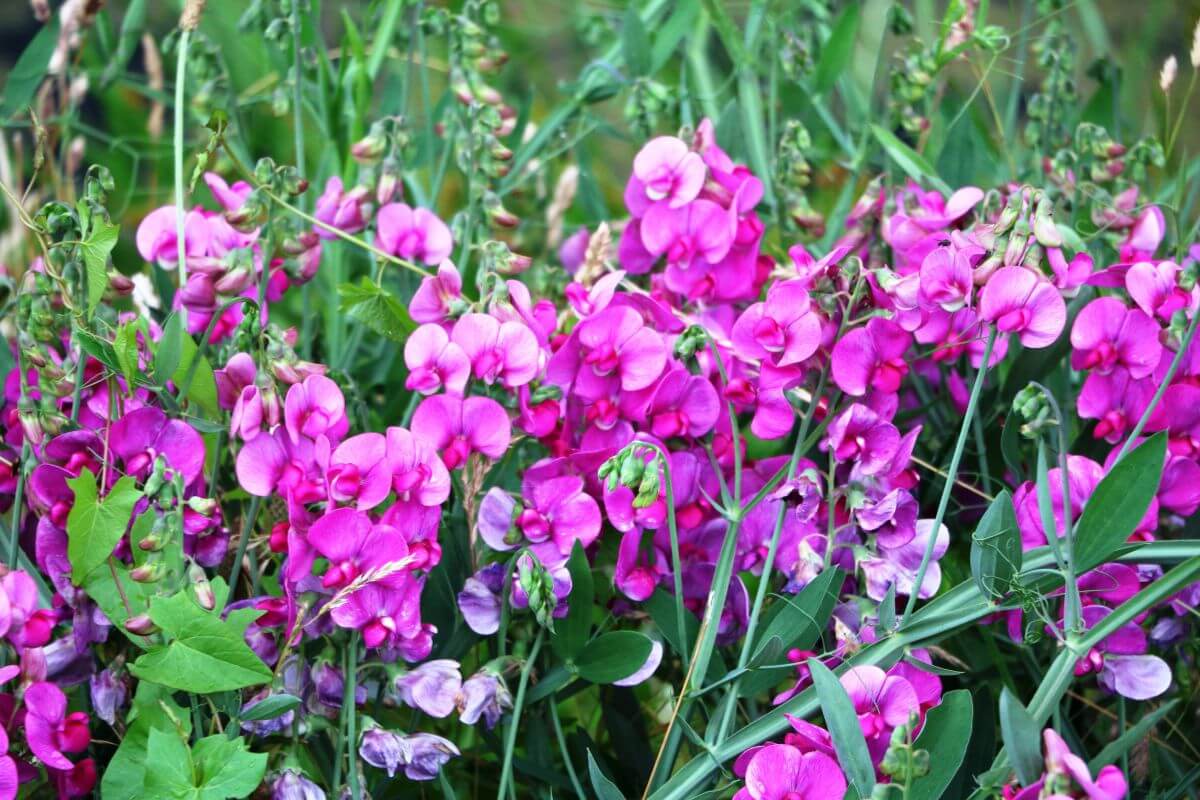
| Attribute | Description |
|---|---|
| Common Name | Everlasting Pea, Perennial Pea, Perennial Peavine |
| Scientific Name | Lathyrus latifolius |
| Growing Information | Perennial, Well-suited for USDA Hardiness Zones: 4-9, Mature Size: 60-120 inches tall, Blooms from Summer to Fall, Thrives in Full Sun to Partial Shade |
This low-maintenance plant can grow like a weed if not controlled. It is a native wildflower to Europe but has been naturalized in North America since the 1700s, and can be found in Montana on sunny banks with clay-rich soil.
Its long tendrils and purplish-pink flowers make it an attractive choice for climbing trellises or fences in gardens. It can also be used as a sprawling ground cover for banks and slopes.
The vibrant pea-shaped blooms of the Everlasting Pea attract butterflies and bees, adding to its appeal. It’s important to note that the colors will fade to white as the plant matures.
25. Crown Vetch
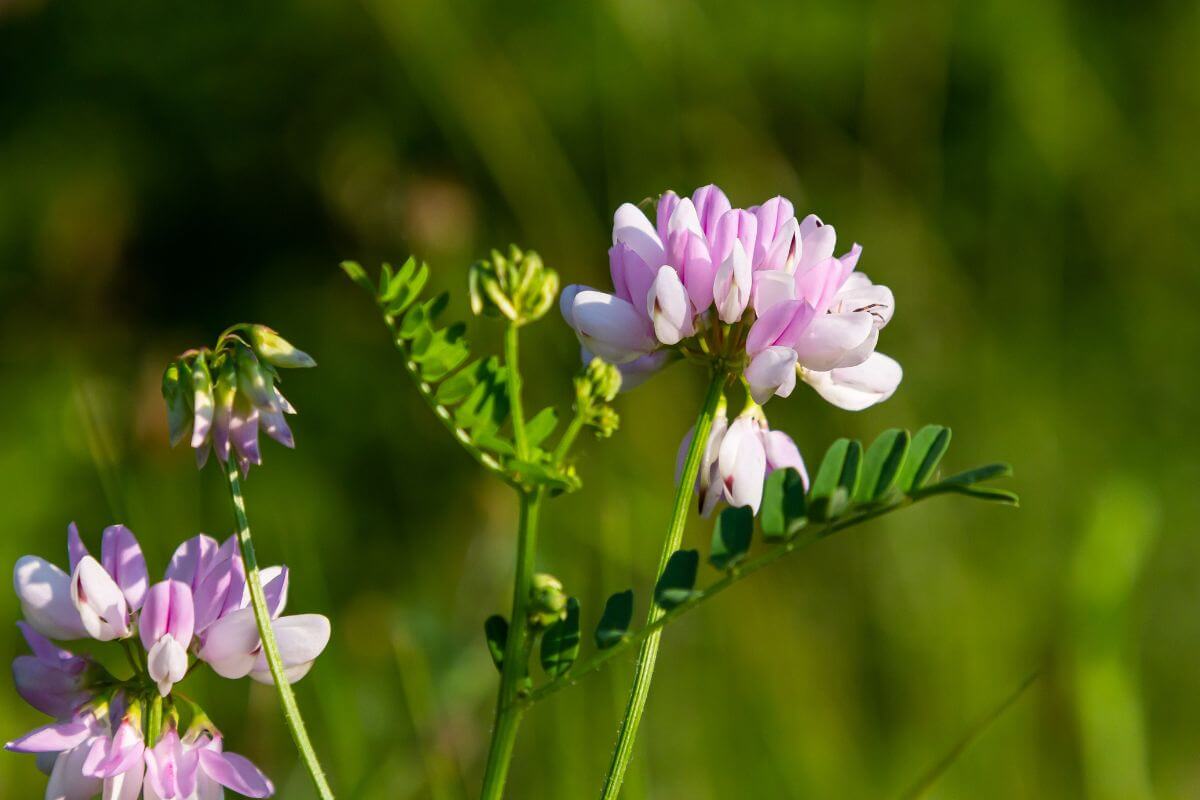
| Attribute | Description |
|---|---|
| Common Name | Crown Vetch, Purple Crown vetch |
| Scientific Name | Securigera varia |
| Growing Information | Perennial, Well-suited for USDA Hardiness Zones: 3-9, Height: 12-72 inches, Blooms from Summer to Fall, Thrives in Full Sun to Partial Shade |
Originally from Europe, Asia, and Africa, Crown Vetch was introduced to control soil erosion, particularly on sunny, sandy banks in Montana. However, if planted, it should be placed in an isolated location far away from flower gardens, and its growth should be carefully controlled to prevent the spreading and invasion of native species and ecosystems.
Despite its beauty, caution should be exercised when considering planting Crown Vetch due to its invasive nature. Proper management and containment are essential to prevent it from overtaking native plant species and disrupting local ecosystems.
26. Birds-Foot Trefoil
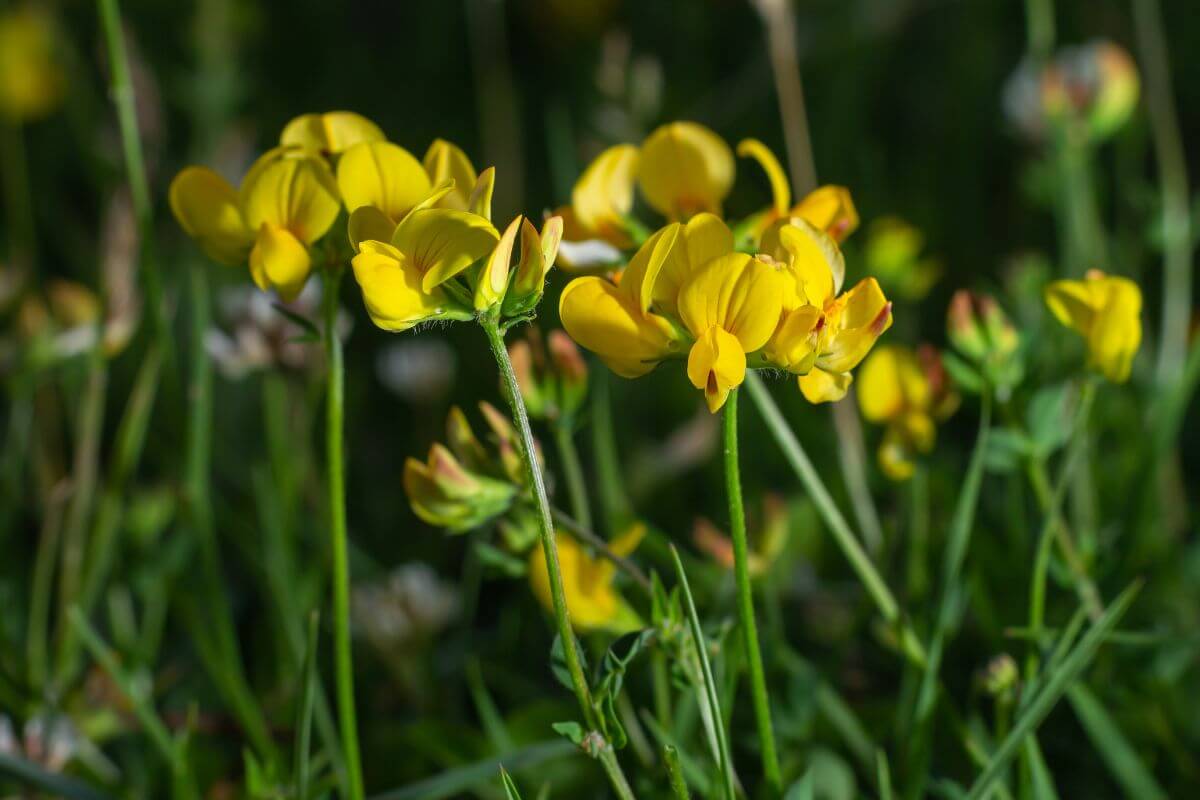
| Attribute | Description |
|---|---|
| Common Name | Birds-foot trefoil, Birdfoot Deervetch, Bloomfell, Cat’s Clover, Crowtoes |
| Scientific Name | Lotus corniculatus |
| Growing Information | Perennial, Suitable for USDA Hardiness Zones: 3-8, Mature Size: 2-8 inches tall, Blooms in Late Spring to Early Summer, Thrives in Full Sun |
Despite its beauty, Birds-foot trefoil is considered invasive in many areas, particularly in sandy soil, fields, parks, and roadsides. It tends to choke out native plants and overtake gardens and fields if left to grow unchecked.
However, when managed properly, this wildflower can be useful. It boasts yellow, orange, and sometimes red-streaked flowers on long stalks that make it visually appealing. Its flowers are crucial for pollinators such as bees, butterflies, and moths, making it an important addition to any pollinator garden with appropriate control and oversight.
27. St. John’s Wort
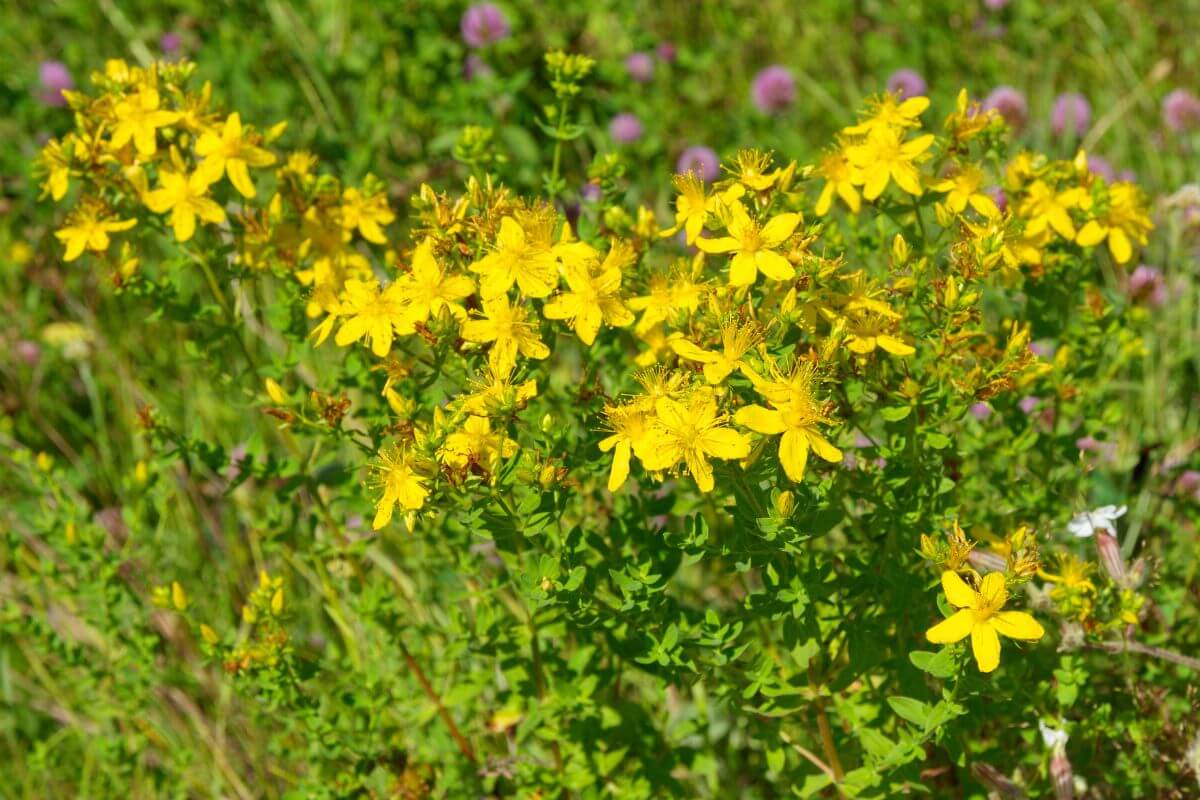
| Attribute | Description |
|---|---|
| Common Name | St. John’s Wort, Klamath Weed, Tipton Weed, Goat Weed |
| Scientific Name | Hypericum perforatum |
| Growing Information | Perennial, Hardy in USDA zones: 3-8, Mature Height: 11-35 inches tall, Blooms in Summer, Thrives in Full Sun to Partial Sun |
The plant is characterized by clusters of showy yellow flowers and can be found in prairies, pastures, disturbed fields, and sandy soils. However, it is considered an invasive species in North America and poses potential harm as it outcompetes other plants and can be fatal to horses, sheep, and other livestock when ingested.
While some bees, butterflies, and beetles feed on the pollen of St. John’s Wort, it is important to prevent the plant from spreading in landscapes due to its negative impact on ecosystems.
It is important to use caution when growing and handling St. John’s Wort to minimize its potential damage to the environment.
28. Sneezeweed
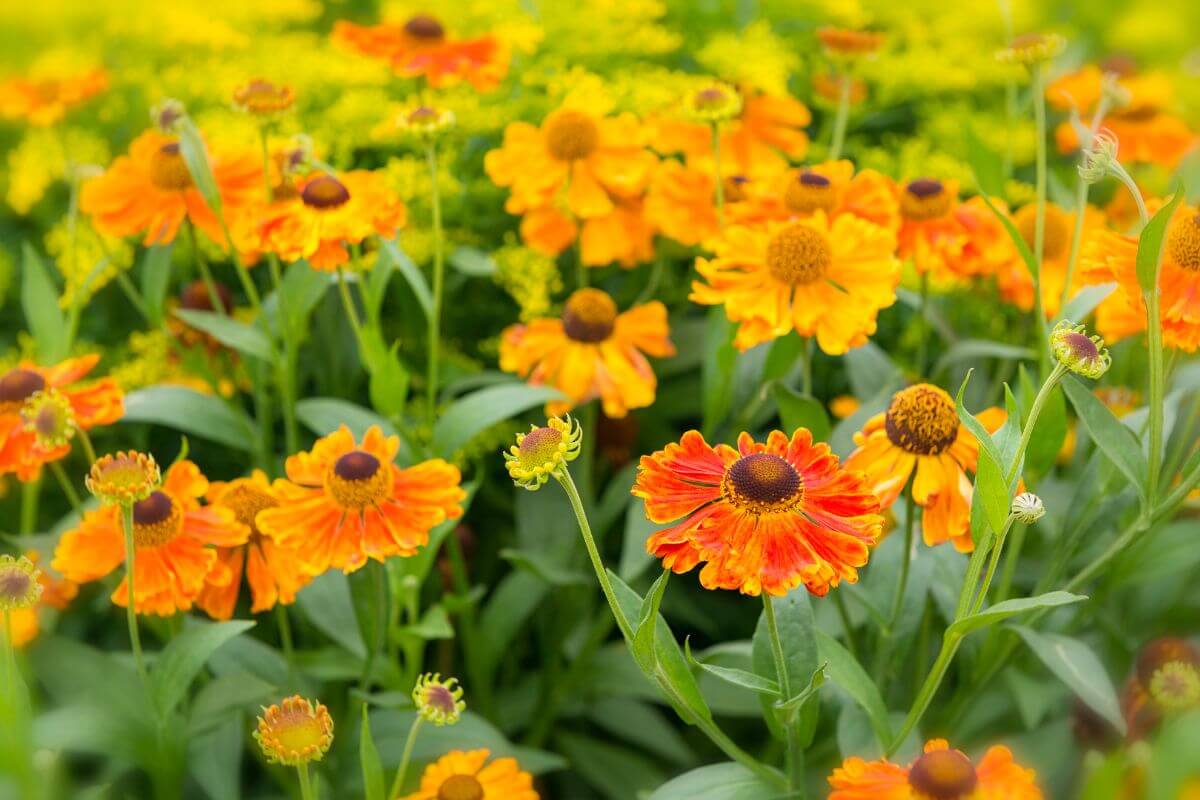
| Attribute | Description |
|---|---|
| Common Name | Sneezeweed, False Sunflower, Bitterweed |
| Scientific Name | Helenium autumnale |
| Growing Information | Perennial, Thrives in USDA Hardiness Zones: 3-8a, Mature Size: 24-60 inches tall, Blooms from Summer to Fall, Prefers Full Sun to Partial Sun Exposure |
It is characterized by pretty daisy-like flowers that bloom in the fall, making it easily identifiable in Montana. It is part of the sunflower family (Asteraceae), which is one of the largest families of flowering plants.
This wildflower can be found along streams, ponds, swamps, and wetlands, and some cultivars with showier flowers are popularly grown in gardens. Despite its misleading name, the pollen from Sneezeweed is not likely to cause allergic reactions.
The name originates from an old medicinal practice of using its leaves to make snuff, a powder that causes sneezing, believed to remove evil spirits from the body. Native bees, honey bees, wasps, butterflies, and beetles are attracted to Sneezeweed.
29. Green-Headed Coneflower

| Attribute | Description |
|---|---|
| Common Name | Green-headed coneflower, Wild Goldenglow, Cutleaf Coneflower, Thimbleweed |
| Scientific Name | Rudbeckia laciniata |
| Growing Information | Perennial, Well-suited for USDA Hardiness Zones: 3-9, Mature Size: 36-108 inches tall, Blooms from Summer to Fall, Prefers Full Sun to Partial Sun Exposure |
They are typically found near woods, stream banks, swamps, and roadside ditches. Their large, tall, and bright yellow flowers make them easily noticeable, attracting bees, butterflies, and other pollinators.
In Montana, they can be grown in prairies and meadows, adding a vibrant pop of color to the landscape. Leaving some flower heads in the fall is important for songbirds like goldfinches that feed on the seeds.
However, the rapid underground spread of their rhizomes means that ample space is needed for this wildflower to grow. Their tall blooms make them better suited for larger landscapes, providing a striking display of yellow throughout the growing season.
30. Wild Parsnip
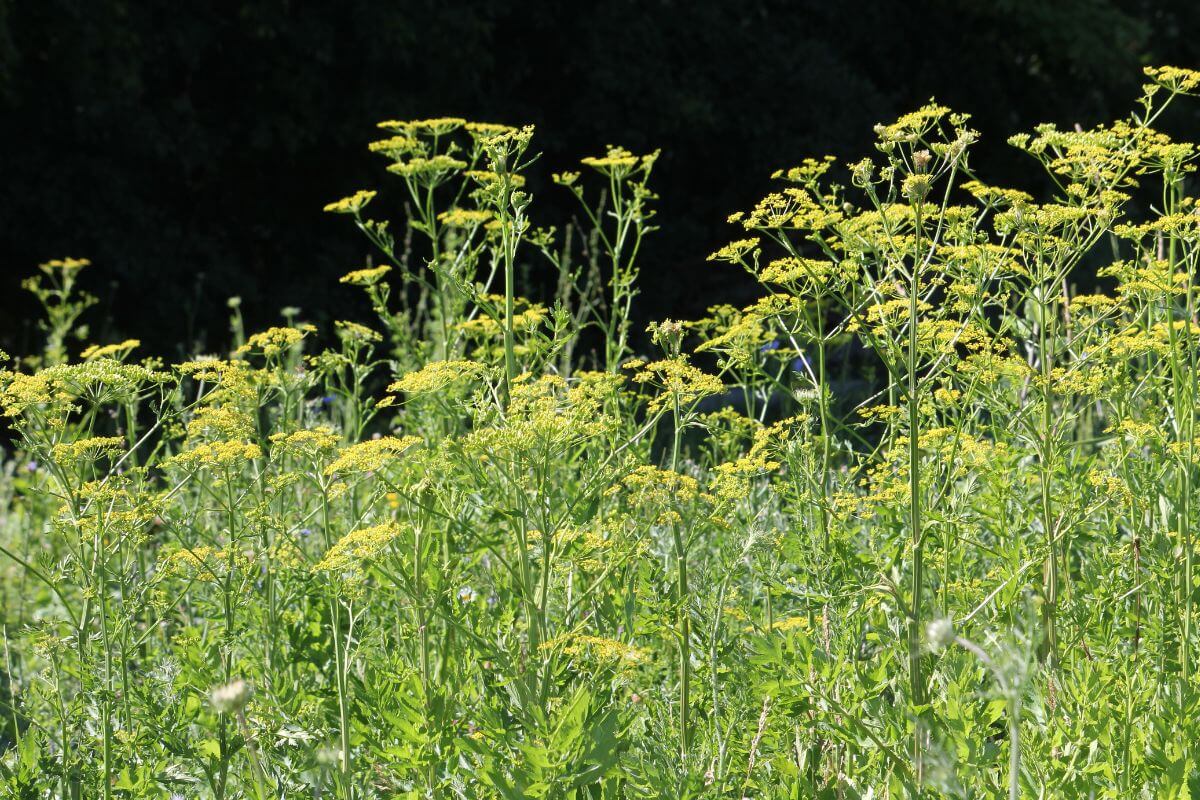
| Attribute | Description |
|---|---|
| Common Name | Wild Parsnip |
| Scientific Name | Pastinaca sativa |
| Growing Information | Biennial or Perennial, Commonly found in USDA Hardiness Zones: 4-8, Mature Size: 48-59 inches, Blooms in Early Summer, Thrives in Full Sun to Partial Sun Exposures |
While Wild Parsnip may resemble cultivated parsnips in taste and smell, it poses a danger due to its leaves and stems, which can cause severe blisters and burns upon contact with the skin. In Montana, this invasive species can be identified by its grooved stems and flat-topped flower clusters of yellow blooms.
In North America, Wild Parsnip poses a significant threat as it spreads rapidly, outcompeting native plants and disrupting natural ecosystems. It is commonly found in ditches, roadsides, and abandoned fields, particularly in early spring when its vivid yellow blooms are visible.
Due to its aggressive nature and potential harm to the environment and humans, it is important to exercise caution and take preventative measures when encountering Wild Parsnip.
31. Goldenrod
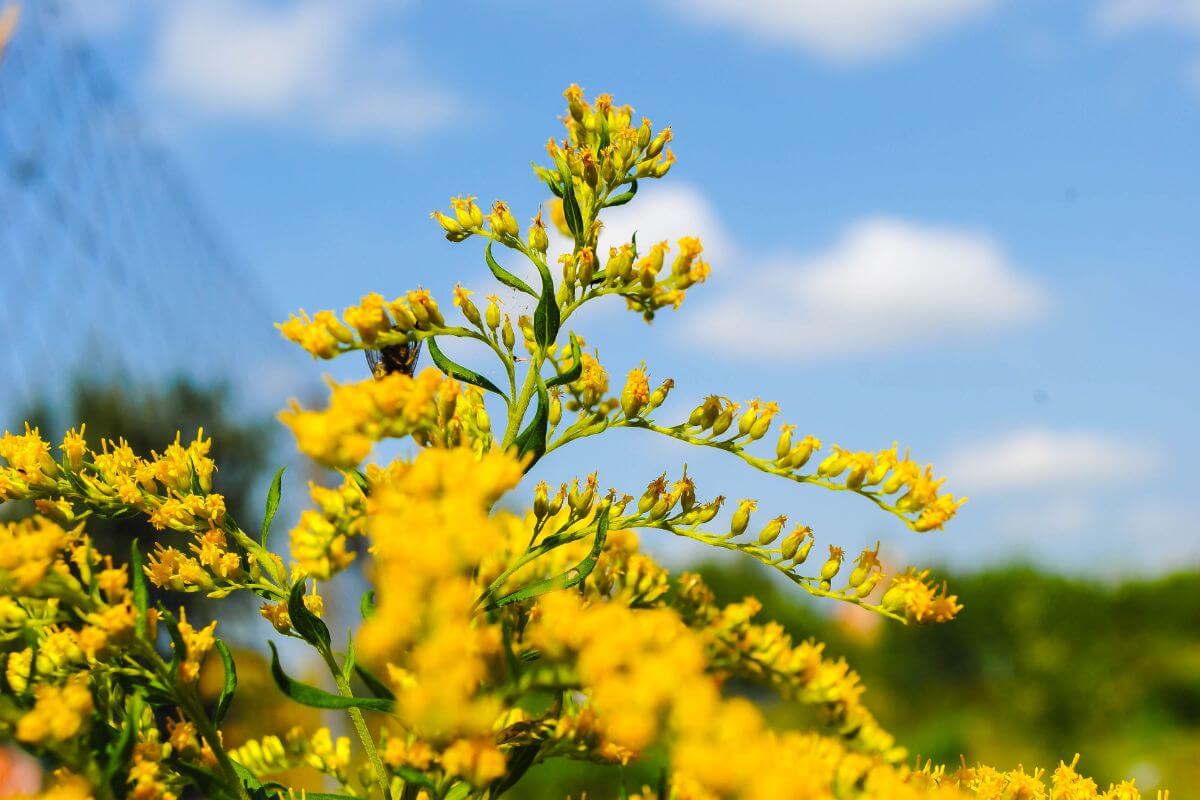
| Attribute | Description |
|---|---|
| Common Name | Goldenrod |
| Scientific Name | Solidago |
| Growing Information | Perennial, Thrives in USDA Hardiness Zones: 3-9, Mature Size: 36-60 inches tall, Blooms from Late Summer to Fall, Thrives in Full Sun |
The diversity of Goldenrod is impressive, with over 120 native wildflower species found throughout North America. The small but striking blooms grow in clusters on branched stems, accompanied by stiff leaves.
Despite its beauty, Goldenrod is often wrongly blamed for hay fever. In reality, its pollen is harmless, and the wild flower is beneficial to various pollinators.
Gardeners should be aware that Goldenrod has the potential for aggressive spread, so containment measures are recommended. To control its growth, consider planting in pots and regular pruning. By taking these steps, you can enjoy the uniquely shaped blooms of Goldenrod without worry.
32. Common Sunflower
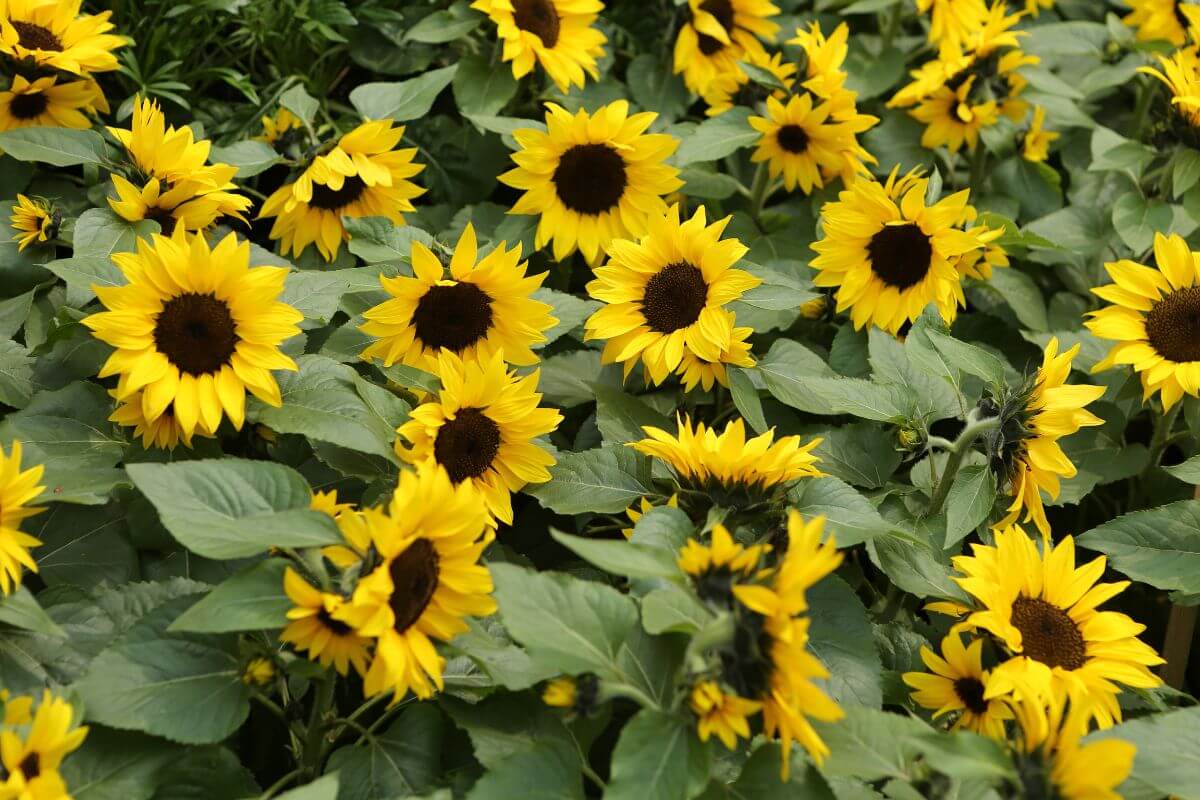
| Attribute | Description |
|---|---|
| Common Name | Common Sunflower |
| Scientific Name | Helianthus annuus |
| Growing Information | Annual, Found in USDA Hardiness Zones: 2-11, Mature Size: 36-120 inches tall, Blooms in Summer, Requires Full Sun Exposure |
With its impressively large yellow petals and attractive dark centers, the common sunflower is a classic sight in late summer and early fall, making it a popular plant worldwide.
They can be found in a variety of habitats in the wild, including prairies, grasslands, old fields, roadsides, and forest edges. They are commonly grown in gardens and enjoyed by both people and animals.
The seeds of the sunflower also provide food for birds and mammals and are edible for humans, making a tasty snack. With its striking appearance and ecological significance, it’s no wonder the common sunflower is a beloved and important plant in various ecosystems.
33. Common Mullein

| Attribute | Description |
|---|---|
| Common Name | Common Mullein |
| Scientific Name | Verbascum thapsus |
| Growing Information | Biennial, Thrives in USDA Hardiness Zones: 3-9, Mature Size: 24-84 inches tall, Blooms in Summer with small yellow flowers densely grouped on a tall stem, Prefers Full Sun, Known for its ability to take over areas like roadsides, meadows, and pasture lands. |
Originally native to Europe, Asia, and Africa, Common Mullein has become naturalized in Montana. It is recognizable by its velvety, dense leaves at the base of the plant and its overall appearance that may resemble corn, with tall stems shooting up from a base of large leaves.
It has medicinal properties and has historically been used in treating pulmonary diseases, inflammations, and various ailments. Today, its dried leaves, flowers, and oil extracts can be found in health stores, where they continue to be used for their potential health benefits.
Common Mullein is a hardy and versatile plant that can add beauty to a natural landscape and offer potential health benefits.
34. Buttercups

| Attribute | Description |
|---|---|
| Common Name | Buttercups |
| Scientific Name | Ranunculus spp. |
| Growing Information | Annual or Biennial, Well-suited for USDA Hardiness Zones: 4-10, Mature Size: 8-18 inches tall, Blooms from Early Spring to Summer, Thrives in Full Sun to Partial Sun |
Known for their vibrant colors, they commonly appear in shades of yellow, orange, pink, red, purple, and cream, adding a gorgeous pop of color to any garden.
- Genus Diversity – Buttercups are a diverse genus of flowers with approximately 600 unique species found worldwide, known for their vibrant colors.
- Versatility and Pollinator Attraction – Buttercups can be cut for floral arrangements and are great for attracting pollinators to the garden.
- Habitat in Montana – These flowers can be found in moist habitats, fields, meadows, and roadsides, adding a burst of color to the landscape during the spring and summer months.
The buttercups are a versatile and stunning addition to any garden, offering a wide range of colors and attracting pollinators while brightening up the landscape with their beautiful blooms.
35. Spiny Sow-Thistle
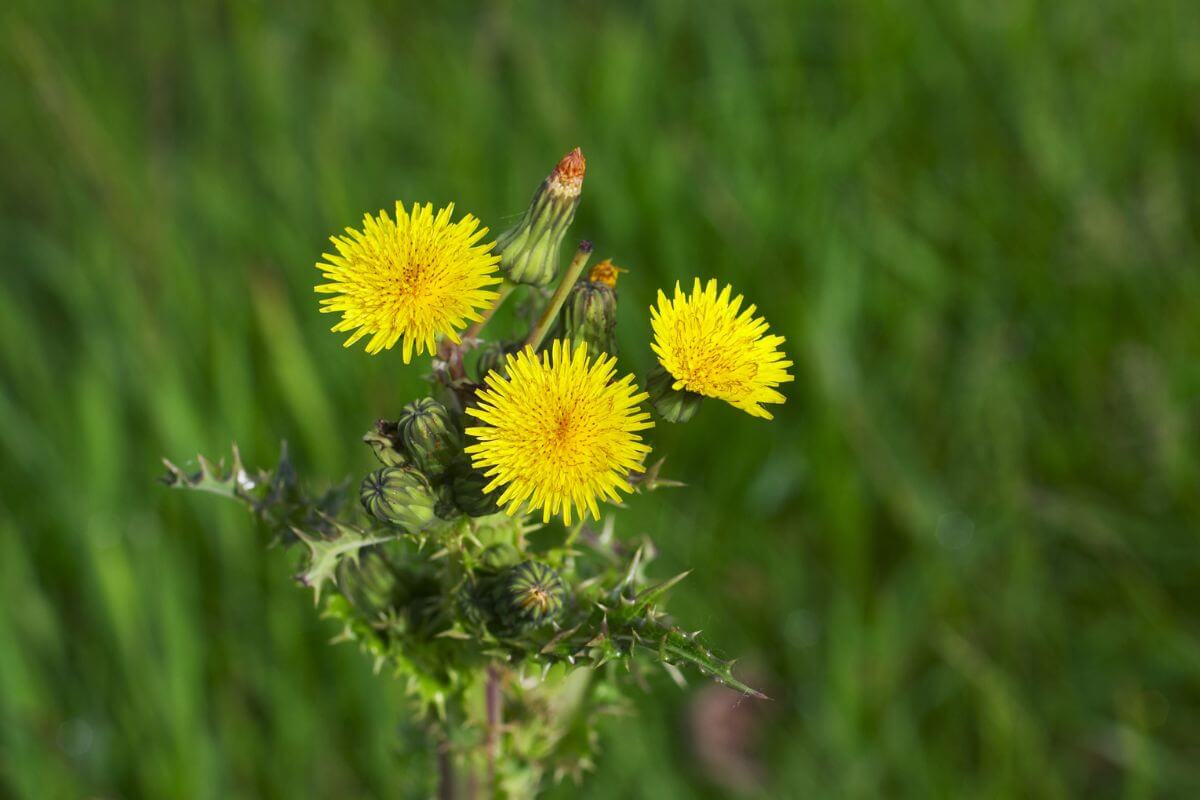
| Attribute | Description |
|---|---|
| Common Name | Spiny Sow-thistle |
| Scientific Name | Sonchus asper |
| Origin | Europe, North Africa, and Asia |
| Growing Information | Invasive, USDA Hardiness Zones: 6b to 9a, Annual or Biennial life cycle, Mature Size: 11-43 inches tall, Blooms from Spring to Summer |
Spiny sow-thistle thrives in full sun to partial shade and can be found throughout Montana in pastures, roadsides, vacant lots, construction sites, grasslands, and waste areas.
Identifying features of spiny sow-thistle include spiky leaves and dandelion-like yellow flowers on tall stems. It is essential to prevent the spread of spiny sow-thistle as it can overwhelm native plants, host diseases, and attract pests that may affect garden plants and crops.
Due to its invasive nature, it is crucial to actively manage and control the spread of this species to preserve the biodiversity of native flora and prevent potential ecological disruptions.
36. Dandelion
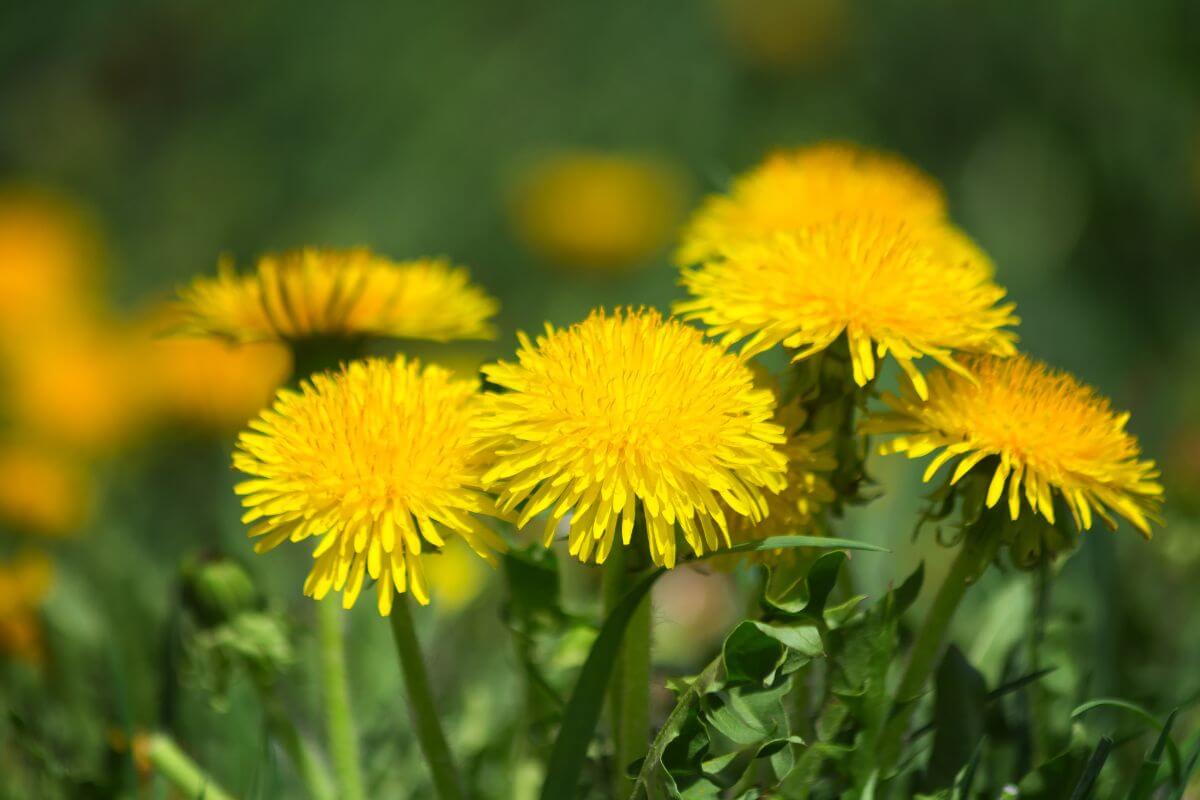
| Attribute | Description |
|---|---|
| Common Name | Dandelion |
| Scientific Name | Taraxacum officinale |
| Growing Information | Perennial, Thrives in USDA Hardiness Zones: 3-10, Mature Size: 6-12 inches tall, Blooms from Spring to Fall, Prefers Full Sun Exposure |
Dandelions can be found in meadows, fields, river shores, lakes, and disturbed habitats in Montana. They are attractive to honeybees and other beneficial insects due to their nectar and pollen.
Originally native to Europe and Asia, dandelions have spread worldwide and are often considered weeds due to their resilience in various soil conditions. Interestingly, dandelions are edible, and their leaves, roots, and flowers can be consumed. The taste of dandelion is honey-like when fresh, but it turns bitter as the plant ages.
Dandelions have a range of culinary uses, including making jam, salad, wine, or tea with their different parts. As a versatile and hardy plant, dandelions are not only a common sight in the wild but also a valuable resource for food and medicine.
37. Indian Hemp
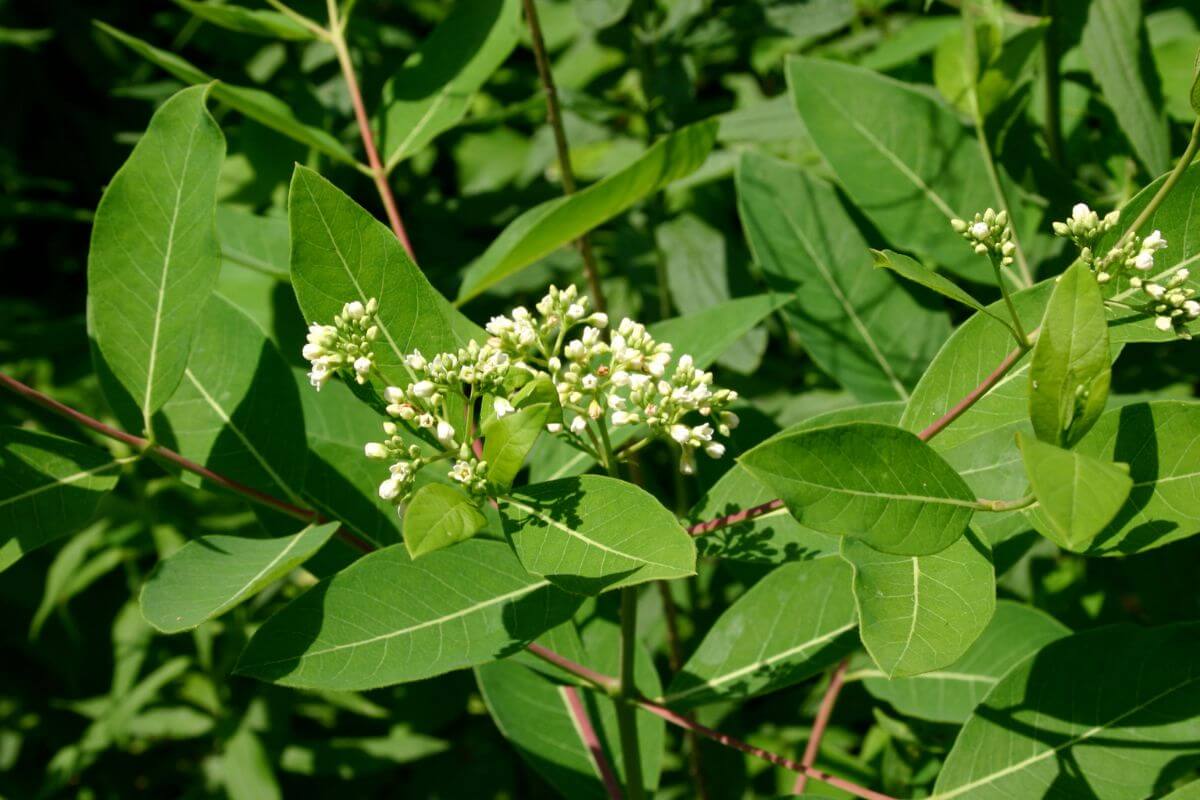
| Attribute | Description |
|---|---|
| Common Name | Indian Hemp |
| Scientific Name | Apocynum cannabinum |
| Origin | Native to North America |
| Growing Information | Perennial, Thrives in USDA Hardiness Zones: 3b-11, Mature Size: 24-60 inches tall, Blooms from Spring to Summer, Prefers Partial Shade to Full Sun |
Despite its native status, Indian Hemp is considered an aggressive weed in Montana and can reduce crop yields on farms. It thrives in dry, rocky woods, meadows, and prairies.
All parts of the Indian Hemp plant are highly toxic to humans, dogs, and livestock, so it should be handled with caution. The milky sap can cause skin blisters, so contact with the plant should be avoided.
Indian Hemp can be identified by its stiff, reddish stems and bushy lance-shaped leaves. The plant’s small white flowers are rich in nectar, attracting butterflies and moths.
Due to its toxic nature and aggressive growth, Indian Hemp requires careful management and is not suitable for all gardens or landscapes.
38. English Plantain
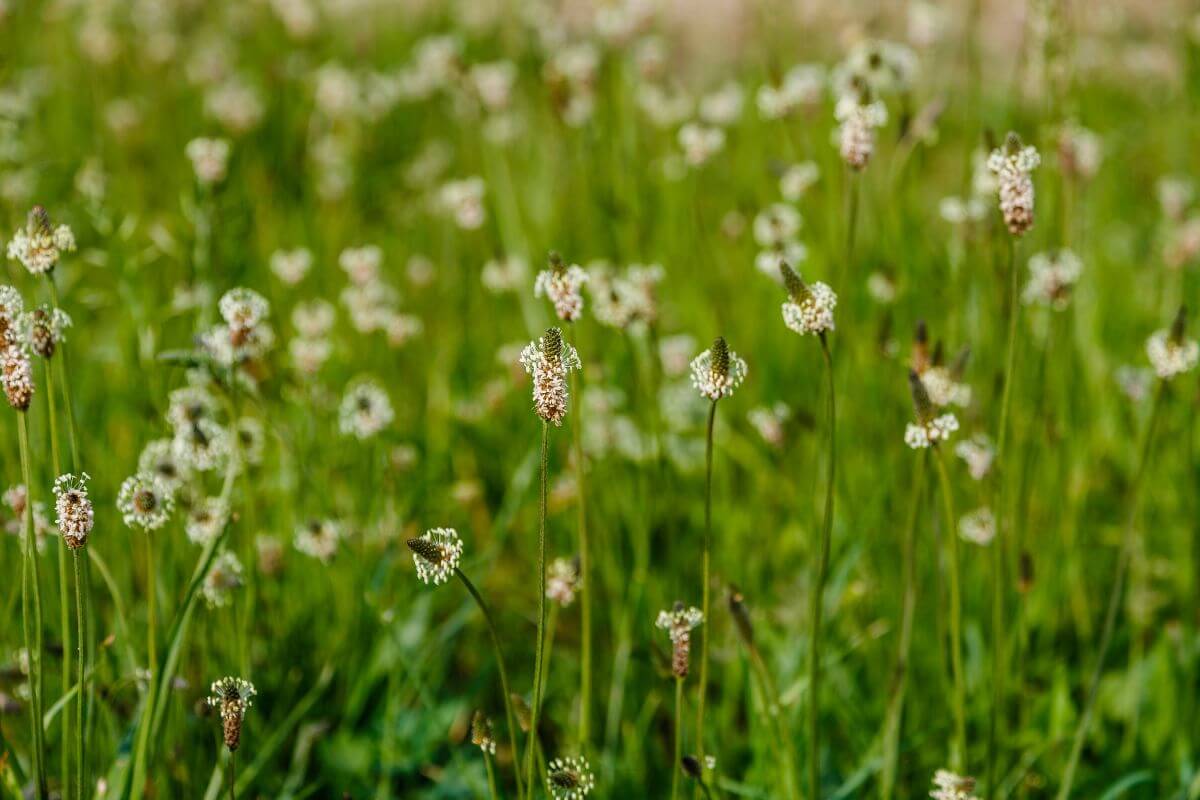
| Attribute | Description |
|---|---|
| Common Name | English Plantain |
| Scientific Name | Plantago lanceolata |
| Origin and Habitat | Originally native to Europe and Asia. Found in disturbed habitats, dry meadows, grazing pastures, and roadsides. |
| Growing Information | Thrives in USDA Hardiness Zones: 5-9a, Mature Size: 4-20 inches tall, Blooms from Spring to Fall, Prefers Full Sun Exposure |
The English plantain is recognizable by its long, hairy, flowering spikes with small and inconspicuous white flowers. The flowers of the English plantain are pollinated by flies and beetles, while the seeds are consumed by songbirds.
This plant has shown adaptive tendencies, altering its growth pattern based on human interventions. For instance, in areas that are frequently mowed, the plant may grow low to the ground to avoid being cut. Its ability to adjust to different environments makes it a resilient and versatile wildflower in Montana.
39. Yarrow
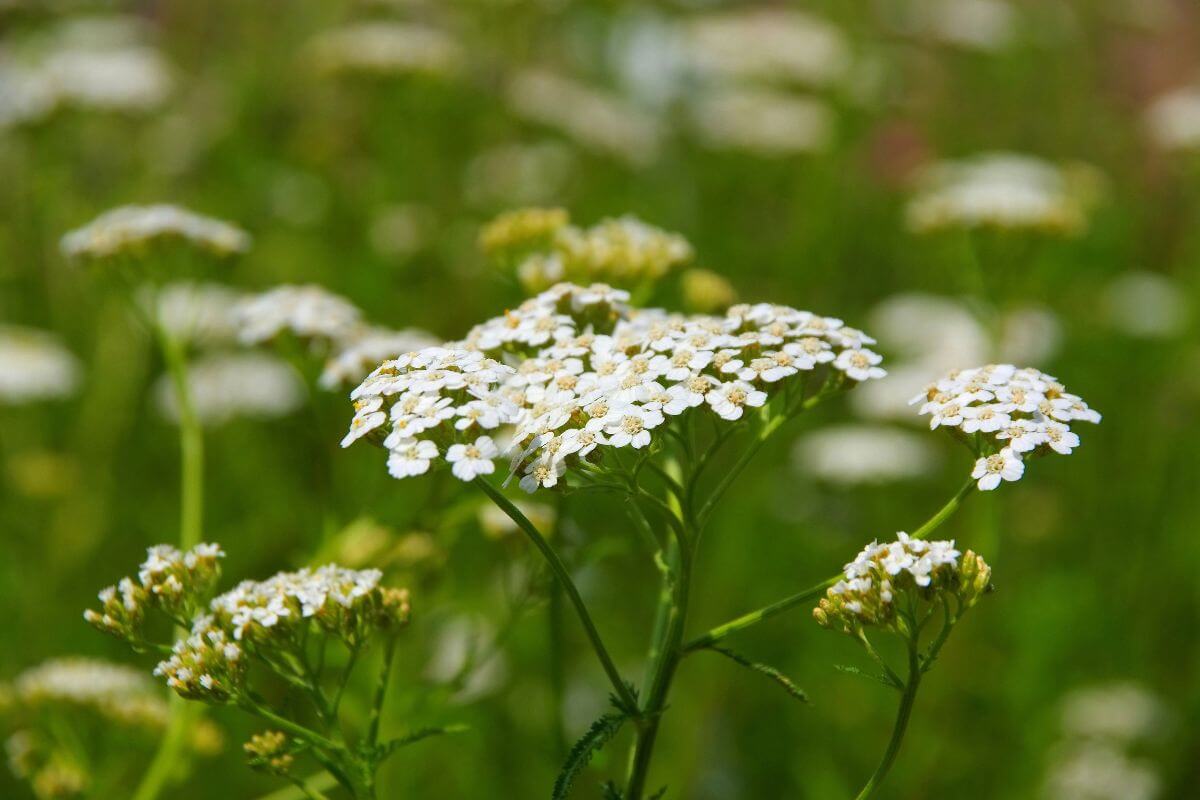
| Attribute | Description |
|---|---|
| Common Name | Yarrow |
| Scientific Name | Achillea millefolium |
| Other Names | Bloodwort, Carpenter’s Weed, Devil’s Nettle |
| Growing Information | Perennial, USDA Hardiness Zones: 3-9, Mature Size: 24-36 inches tall, Blooms in Summer |
| Characteristics | Abundant flowers in clusters, small feathery leaves resembling ferns, scent reminiscent of chrysanthemums (mums) |
Colorful hybrids of Yarrow have been developed, attracting pollinators such as bees, wasps, beetles, moths, and butterflies to the garden. The plant naturally occurs in disturbed areas, grasslands, open forests, and roadsides.
Yarrow is known for its ability to tolerate drought and thrive in less-than-perfect conditions, making it a hardy and reliable addition to any garden. Whether cultivated for its ornamental appeal or its historical medicinal uses, Yarrow is a versatile and valuable plant for any landscape.
40. Catnip
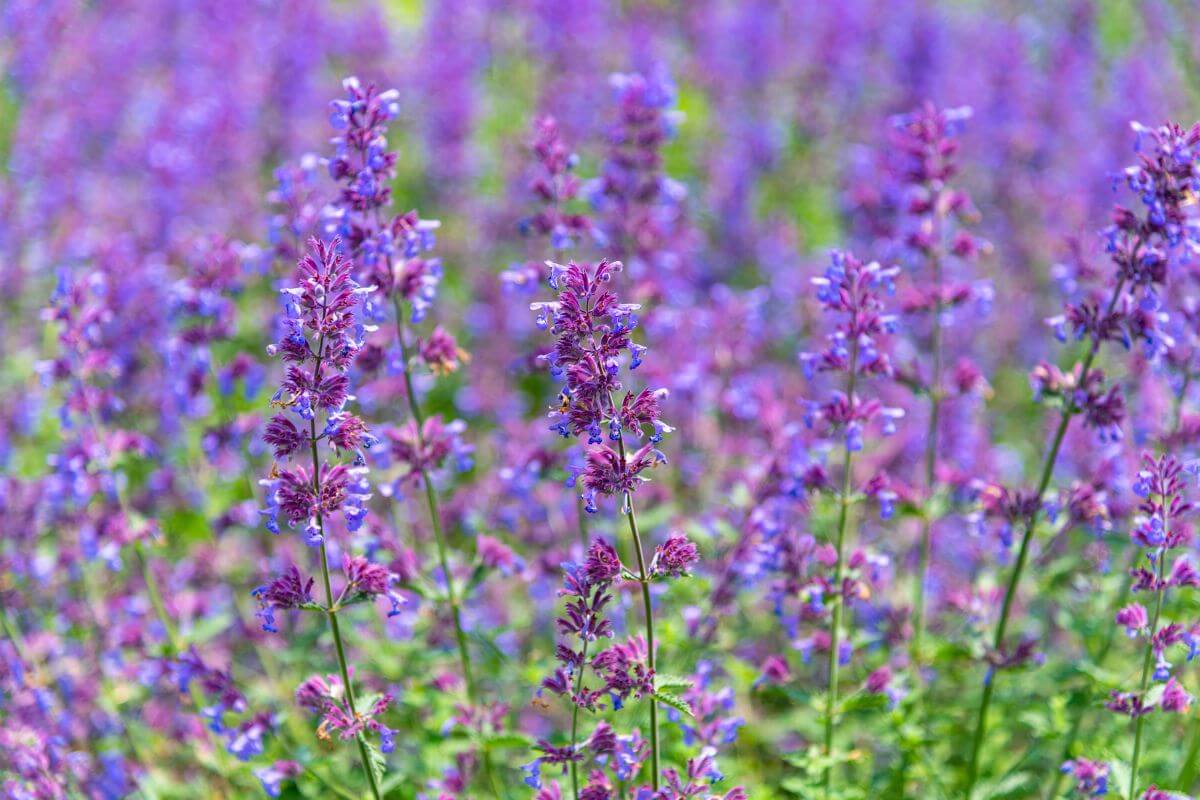
| Attribute | Description |
|---|---|
| Common Name | Catnip |
| Scientific Name | Nepeta cataria |
| Other Names | Catswort, Catmint, Field Balm |
| Family | Mint family (Lamiaceae) |
| Growing Information | Perennial herb, USDA Hardiness Zones: 3-9a, Mature Size: 24-36 inches tall, Blooms from Spring to Fall |
| Characteristics | Aromatic leaves that can repel mosquitoes, cockroaches, and termites |
Its triangular, veiny leaves and small white or purple spotted flowers are distinguishing features, attracting various pollinators such as bees, butterflies, wasps, flies, and birds like goldfinches that eat the seeds in the fall.
Catnip thrives best in full sun and well-drained soils, making it a low-maintenance and versatile plant for gardens and landscapes. Whether for its practical uses or its appeal to beloved feline companions, catnip is a fascinating and valuable addition to any green space.
41. Whorled Milkweed
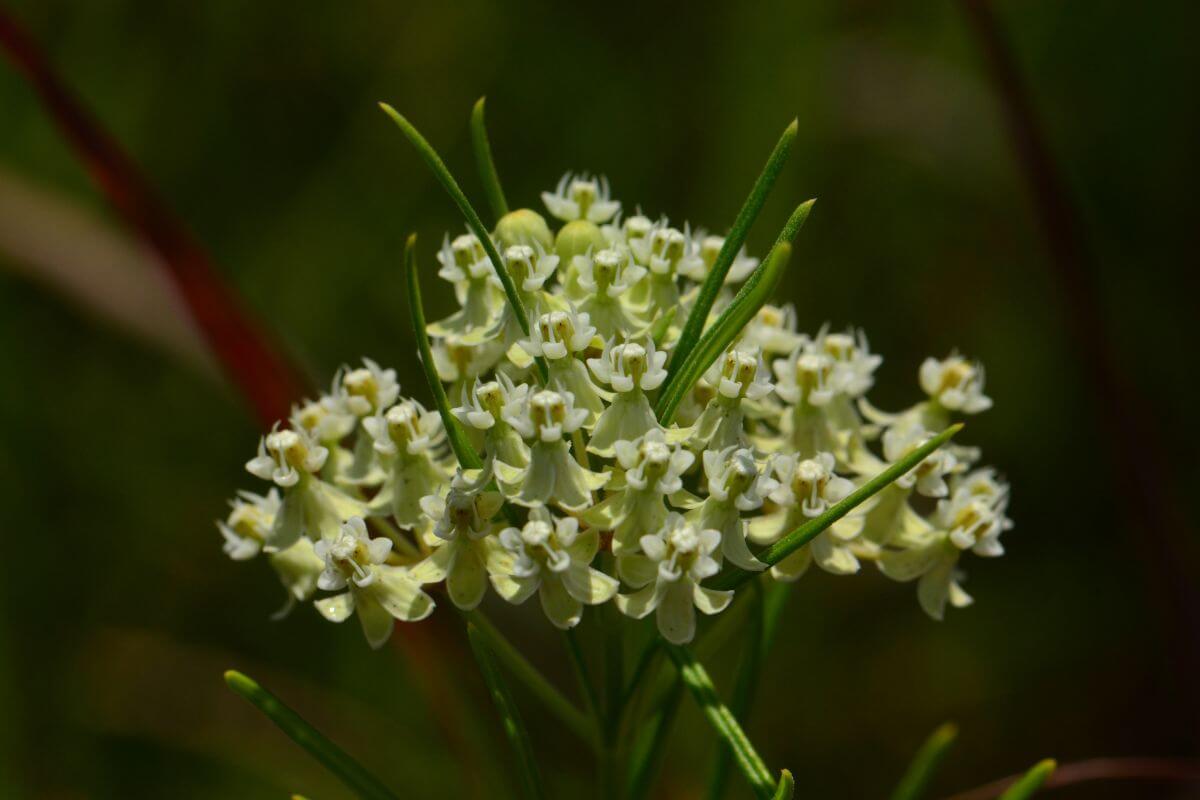
| Attribute | Description |
|---|---|
| Common Name | Whorled Milkweed |
| Scientific Name | Asclepias verticillata |
| Other Names | Eastern Whorled Milkweed, Horsetail Milkweed |
| Growing Information | Perennial wildflower, Thrives in USDA Hardiness Zones: 4-9a, Mature Size: 12-36 inches tall, Blooms in Summer |
| Habitat | Predominantly found in dry prairies, open woods, fields, and roadsides in Montana |
This plant features flat-topped clusters of 7-20 small, fragrant white flowers that attract a diverse range of pollinators, including hummingbirds, bees, wasps, butterflies, flies, skippers, and beetles. It is especially crucial as a food source for Monarch butterflies and their caterpillars.
Despite its quick spread through underground rhizomes, Whorled Milkweed is not considered invasive, making it an excellent choice for gardens. It is known for its resilience against drought, easy self-seeding, and tolerance for various soil types.
Whorled Milkweed is a valuable addition to any garden, providing essential nectar and hosting capabilities for a wide array of pollinators, while also supporting the iconic Monarch butterfly.
42. Oxeye Daisy
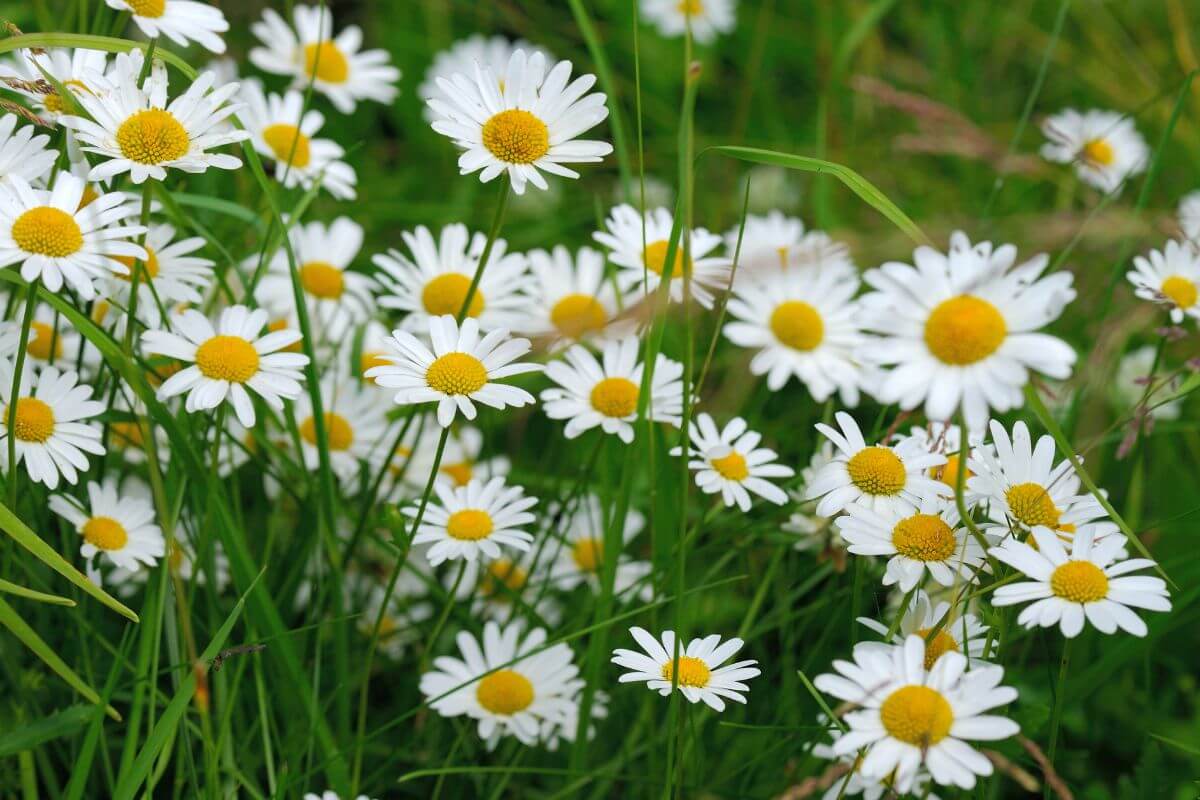
| Attribute | Description |
|---|---|
| Common Name | Oxeye Daisy |
| Scientific Name | Leucanthemum vulgare |
| Other Names | Dog Daisy, Marguerite, White Weed |
| Appearance | Beautiful wildflower with white petals surrounding yellow disc-shaped centers |
| Growing Information | Thrives in USDA Hardiness Zones: 3-8a, Mature Size: 12-24 inches tall, Blooms from Spring to Summer |
| Characteristics | Adds a touch of elegance to any garden or natural landscape |
- Origin and Invasive Nature – The oxeye daisy is originally from Europe and is considered an invasive species in Montana. Its aggressive spread through seeds and underground rhizomes allows it to colonize native ecosystems in grassy fields, meadows, disturbed sites, and open woodlands, outcompeting native plants.
- Pollination – It is capable of self-fertilization but also relies on assistance from bees, flies, beetles, moths, and butterflies. This makes it an important source of nectar for various pollinators.
- Popularity and Caution – Despite its invasive nature, the oxeye daisy remains a popular choice for many gardeners due to its attractive appearance and ease of care. However, it’s important to be mindful of its potential to spread and impact local ecosystems.
43. White Clover
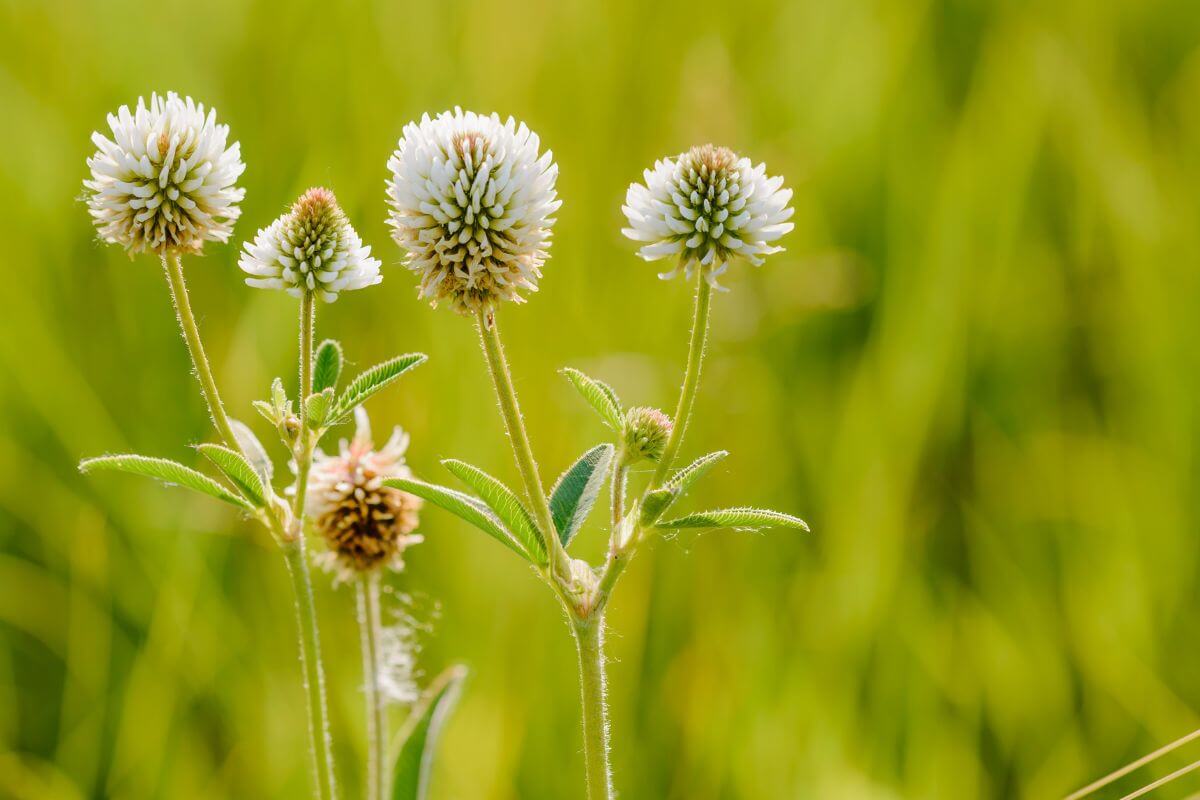
| Attribute | Description |
|---|---|
| Common Name | White Clover |
| Scientific Name | Trifolium repens |
| Other Names | Dutch Clover, Shamrock, Honeysuckle Grass |
| Growing Information | A perennial plant that thrives in USDA Hardiness Zones: 3-10a, Mature Size: 4-6 inches tall, Blooms from Spring to Fall |
| Origin | Native to Europe and Asia, now considered a naturalized species in Montana |
Known for its vigorous growth, white clover can dominate lawns, roadsides, pastures, and waste areas, but it generally does not outcompete native vegetation. It features creamy white, rounded flowers that bloom abundantly, along with distinctive green leaves containing three leaflets, and occasionally, four-leaf finds.
All parts of white clover are edible, making it a versatile plant. The dried flowers can be used to make tea, and the young leaves can be added to salads. The flowers and seed pods can be ground and sprinkled as a seasoning on cooked food, providing a subtle vanilla-like flavor.
White clover is known for its ability to thrive and spread, offering not only aesthetic appeal but also a range of culinary possibilities.
44. Spotted Coralroot
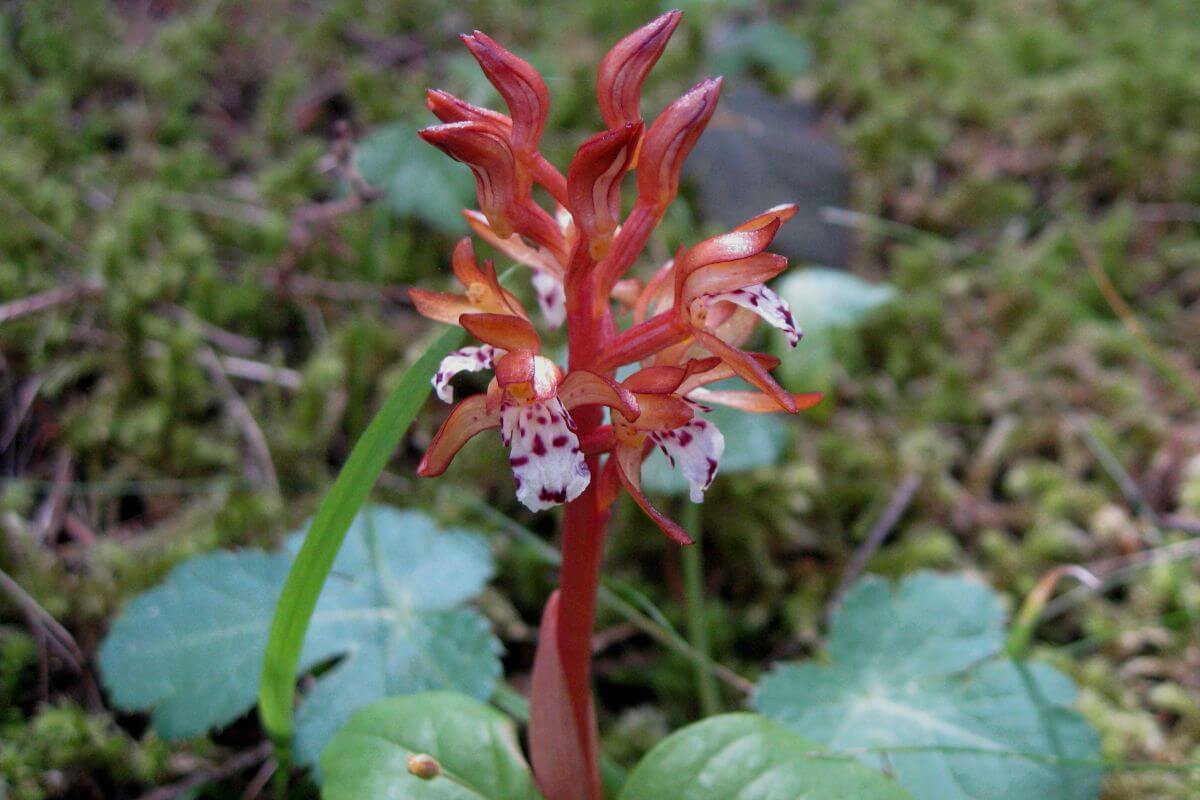
| Attribute | Description |
|---|---|
| Common Name | Spotted Coralroot |
| Scientific Name | Corallorhiza maculata |
| Other Names | Summer Coralroot, Speckled Coral Root, Many-flowered Coral Root |
| Appearance | Lacks leaves; bare stalks produce clusters of flowers, creating an intriguing and delicate appearance |
| Growing Information | Found in wooded areas in Montana, Mature Size: 3.9-31 inches tall, Blooms in early summer |
One of the most unique features of Spotted Coralroot is its lack of leaves. It relies on mycorrhizal fungi for nutrients, as it cannot perform photosynthesis. Mining bees are attracted to Spotted Coralroot and play a vital role in pollination. The plant is capable of self-pollination by transferring pollen as its flower opens.
Spotted Coralroot is a fascinating addition to wooded areas, with its distinctive appearance and interesting methods of obtaining nutrients and reproduction.
45. Orange Hawkweed
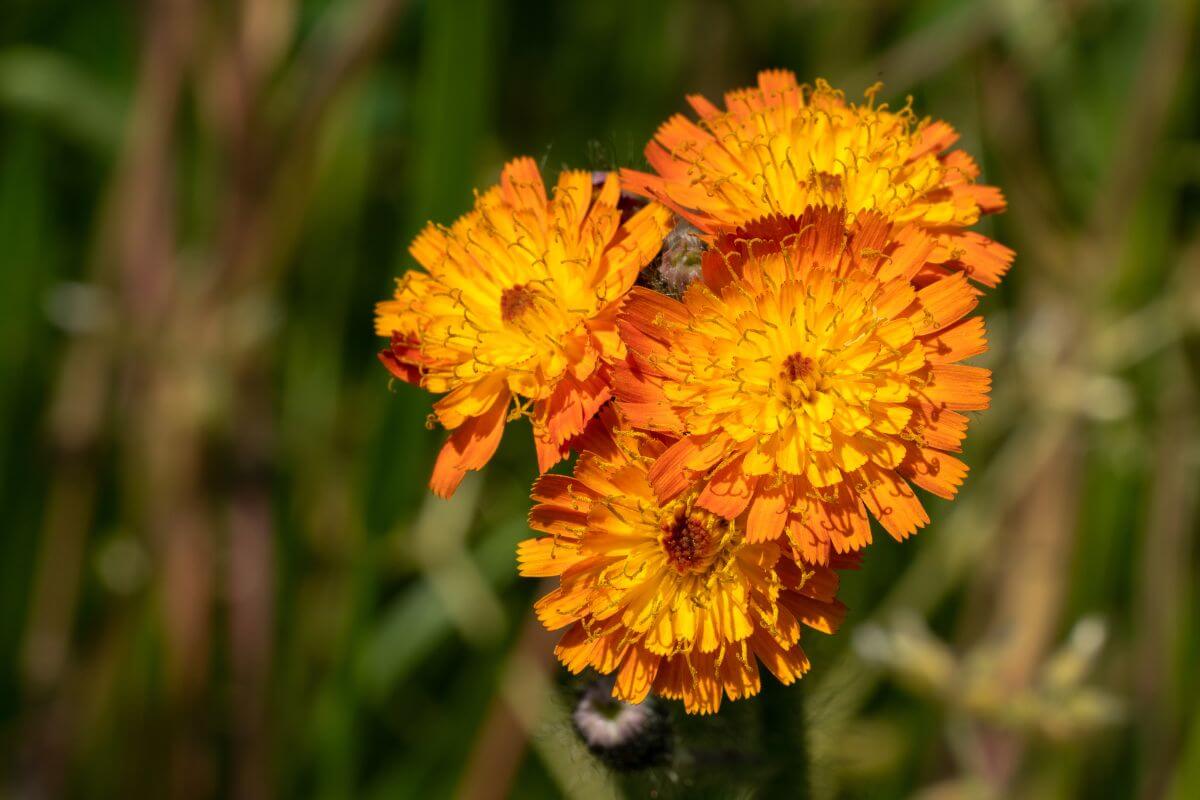
| Attribute | Description |
|---|---|
| Common Name | Orange Hawkweed |
| Scientific Name | Hieracium aurantiacum |
| Other Names | Orange Hawkbit, Orange Aster, Devil’s Paintbrush, King Devil Hawkweed, Devil’s Weed, Tawny Hawkweed, Red Daisy Flameweed, Grim-the-collier, Fox, Cubs |
| Appearance | Grows to approximately 10-24 inches tall; coppery, orange-red to yellow flowers with black tips |
| Growing Information | Blooms from summer to early fall, Well-suited for USDA Hardiness Zones: 5-10, Prefers full sun or partial shade |
Introduced to Montana in the 1800s, Orange Hawkweed has become a popular ornamental plant. However, it should be noted that this species grows aggressively fast. In 2009, research revealed that most Orange Hawkweed populations in North America are genetic clones of one another, originating from the same plant.
Interestingly, ancient Greeks believed that the milky sap of hawkweeds gave hawks their sharp eyesight. This plant’s ability to spread and dominate is something to be aware of when considering its introduction into a garden or natural area.
46. Wood Lily
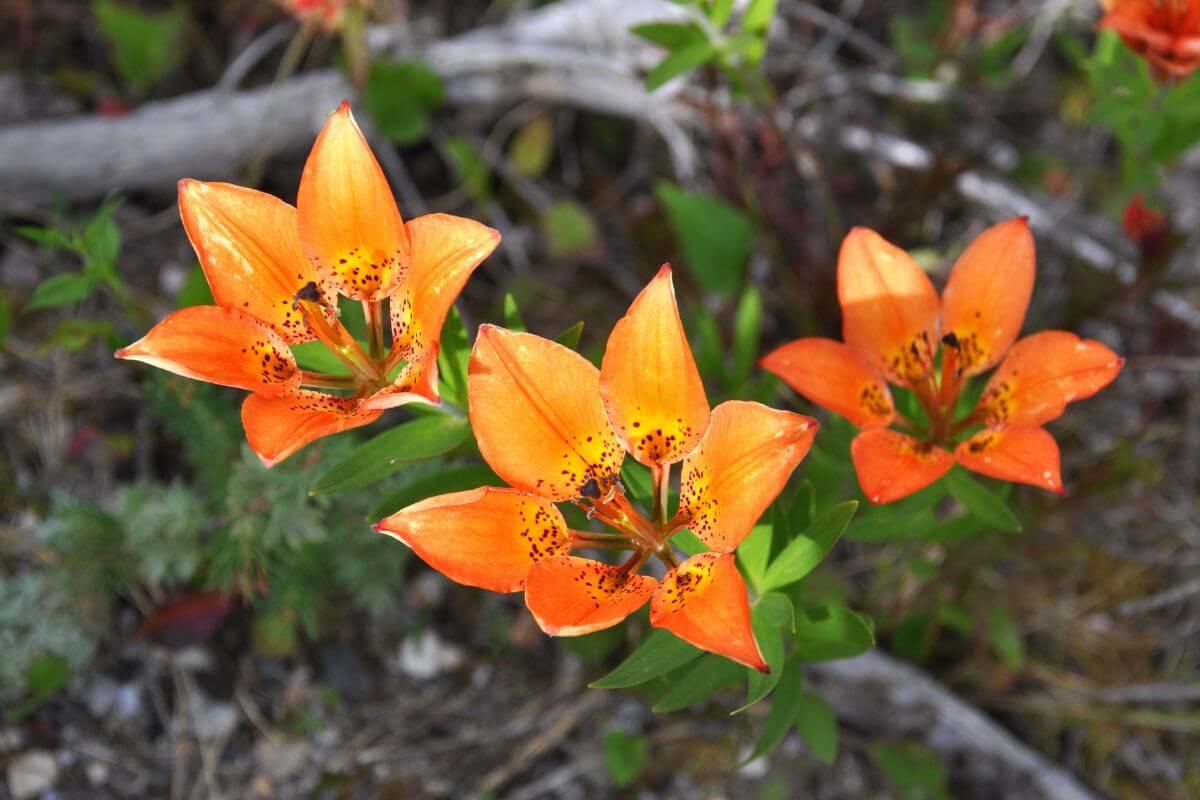
| Attribute | Description |
|---|---|
| Common Name | Wood Lily |
| Scientific Name | Lilium philadelphicum |
| Other Names | Red Lily, Prairie Lily, Western Red Lily, Northern Red Lily, Philadelphia Lily |
| Appearance | Stunning orange wildflower |
| Growing Information | Perennial, Thrives in USDA Hardiness Zones: 4-8, Mature Size: 12-36 inches tall, Bloom time: mid-summer to late summer, Prefers full sun or partial shade |
This unique flower attracts hummingbirds and butterflies with its upward-facing petals, designed for effective cross-pollination. The striking red-orange flowers with purplish freckles make it a favorite among gardeners.
Each flower remains open for 8-11 days, and unlike many wildflowers in Montana, the petals of the wood lily don’t immediately close or wither after pollination. Interestingly, the bulbs of the wood lily are edible, with a flavor similar to turnips.
However, conservation concerns have arisen as wood lilies are often picked from their natural habitat by visitors, leading to a decrease in their commonality. It is important to appreciate and protect these beautiful wildflowers to ensure their continued presence in the natural landscape.
47. Blanket Flower
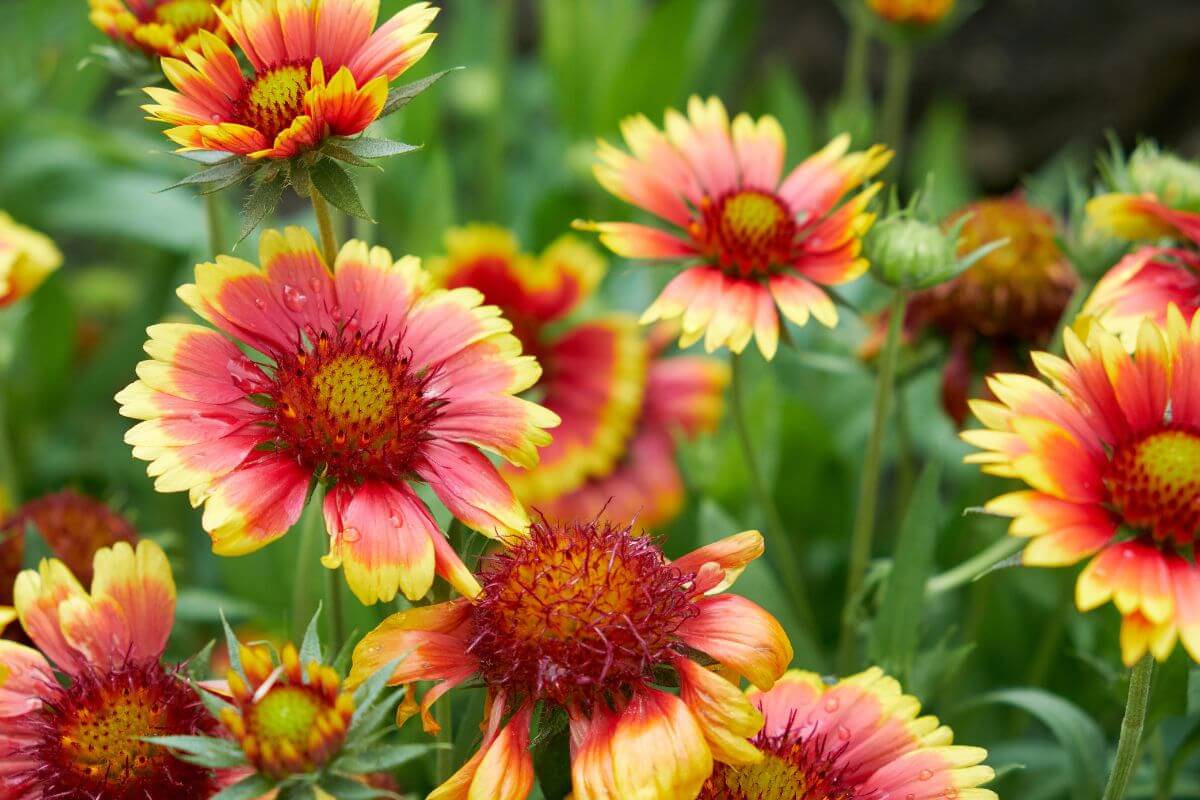
| Attribute | Description |
|---|---|
| Common Name | Blanket Flower |
| Scientific Name | Gaillardia pulchella |
| Other Names | Indian Blanketflower, Beach Blanket-flower, Indian Blanket Flower, Firewheel, Sundance, Girasol Rojo, Gaillardia |
| Appearance | Common orange wildflower |
| Growing Information | Annual, Thrives in USDA Hardiness Zones: 2-11, Mature Size: 12-24 inches tall, Bloom time: summer to early fall (may bloom year-round in some areas), Prefers full sun or light shade |
| Petal Colors | Striking red, orange, and yellow petals |
This vibrant flower is a magnet for bees and birds, making it a valuable addition to any garden. Beekeepers also use blanket flowers in honey production, resulting in mild, buttery, amber-colored honey. Goldfinches enjoy the seeds of blanket flowers, so it’s advisable to leave some seedheads after the flowering season.
Blanket flower is a beautiful and beneficial addition to any garden, not only for its stunning appearance but also for its ability to attract pollinators and provide food for birds.
Montana Wildflowers Final Thoughts
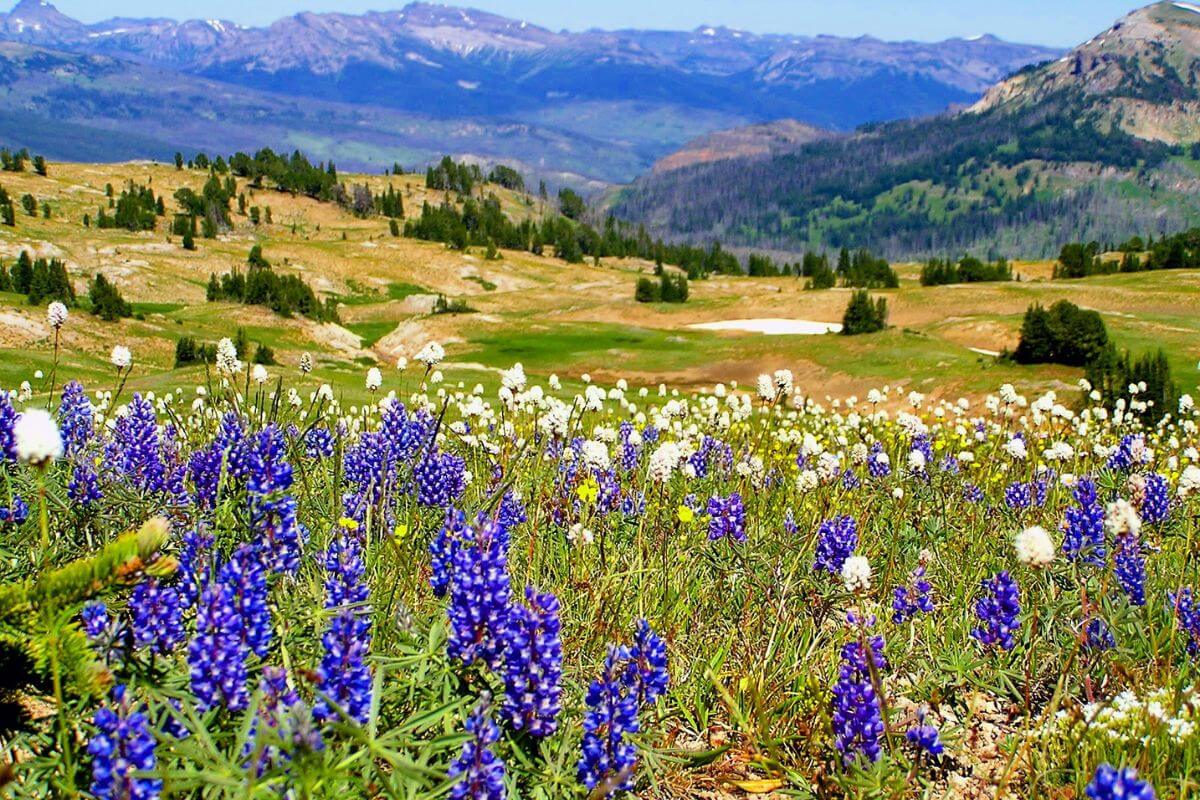
Montana’s wildflowers form a vibrant tapestry of 47 species, each contributing to the state’s natural beauty and ecological richness.
Iconic species like the Common Sunflower, with its large yellow petals and valuable seeds, and the elusive Shooting Stars, including Pretty Shootingstar, Jeffrey’s Shootingstar, and Few-flowered Shootingstar, showcase their unique characteristics.
Noteworthy wildflowers such as the aggressive yet captivating Orange Hawkweed and the delicate Wood Lily add to the state’s botanical allure. The native Glacier Lily, thriving in mountain meadows with lemon-yellow blossoms, presents two distinct varieties.
Montana also grapples with challenges posed by some wildflowers, like the invasive Oxeye Daisy, while benefiting from the multifaceted uses of others, such as the medicinal Yarrow and resilient White Clover. Each wildflower in Montana has a diverse story to tell, from Blanket Flower’s beauty to catnip’s historical significance and Wild Parsnip’s toxicity.
These wildflowers narrate a tale of adaptation, survival, and interconnectedness, underscoring the importance of appreciating and conserving the rich botanical heritage of this enchanting region. Montana’s wildflowers are not just beautiful, they are essential components of the state’s natural ecosystems and a source of ecological wonder.
Don’t stop here! Dive into our archives for a wealth of related content:
- https://www.fs.usda.gov/wildflowers/pollinators/documents/NativeWildflowersBeesWesternMontana.pdf
- https://app.mt.gov/shop/mhsstore/copy-of-montana-wildflowers
- https://app.mt.gov/shop/mhsstore/montana-trees-wildflowers-a-folding-pocket-guide-to-familiar-species
- https://www.fs.usda.gov/wildflowers/viewing/
- https://www.nps.gov/glac/learn/nature/wildflowers.htm
- https://www.flickr.com/photos/yellowstonenps/36500053011
- https://commons.wikimedia.org/wiki/File:Apocynum_cannabinum_6801.JPG
- https://www.flickr.com/photos/wackybadger/9369383148
- https://www.flickr.com/photos/brewbooks/4553397637
- https://www.flickr.com/photos/fsnorthernregion/5954738596

